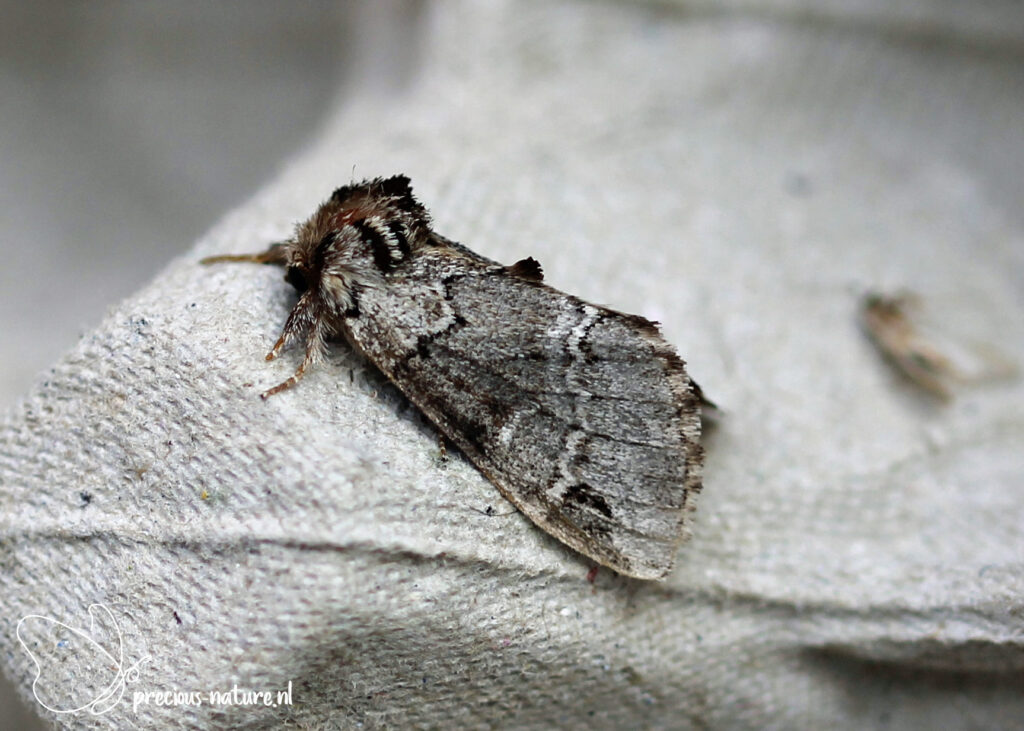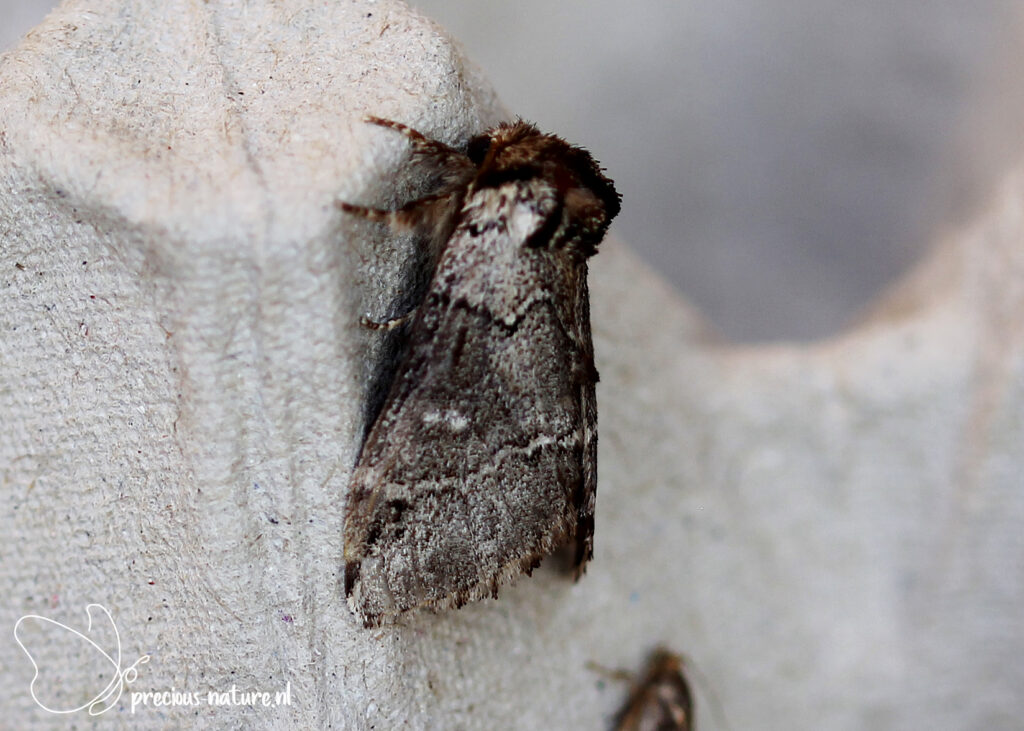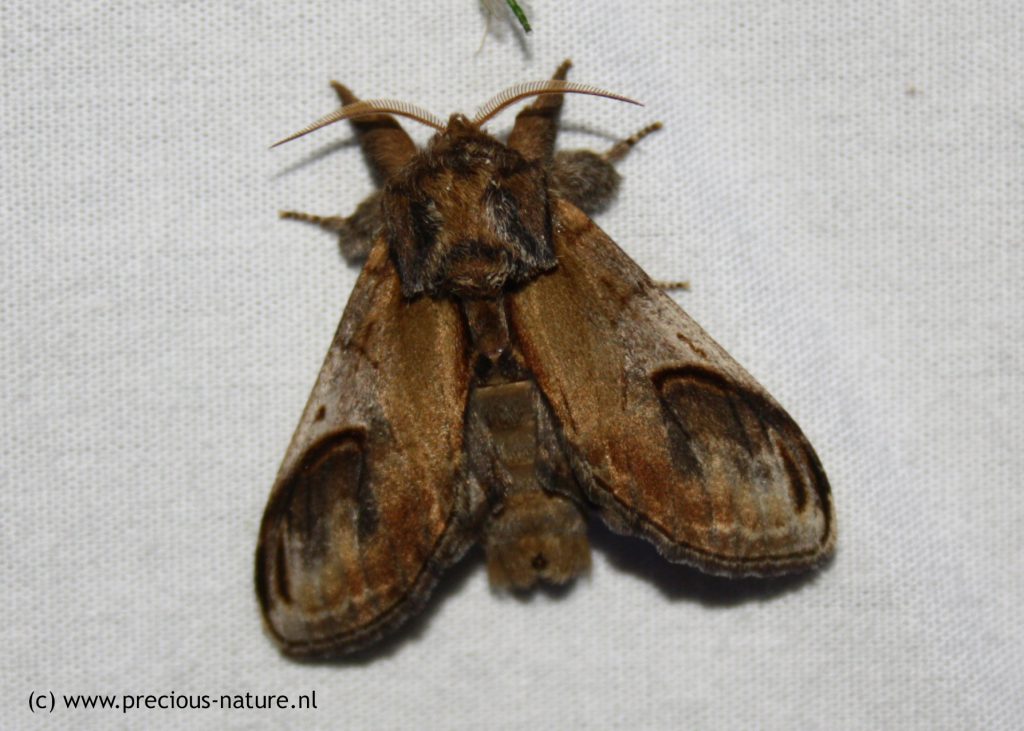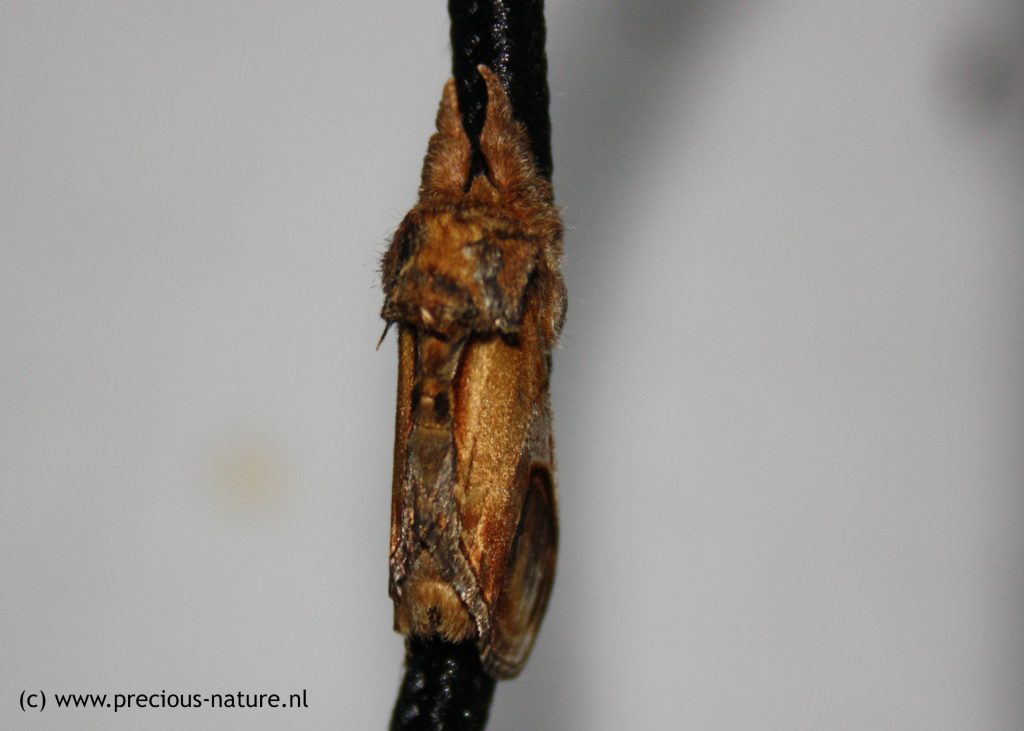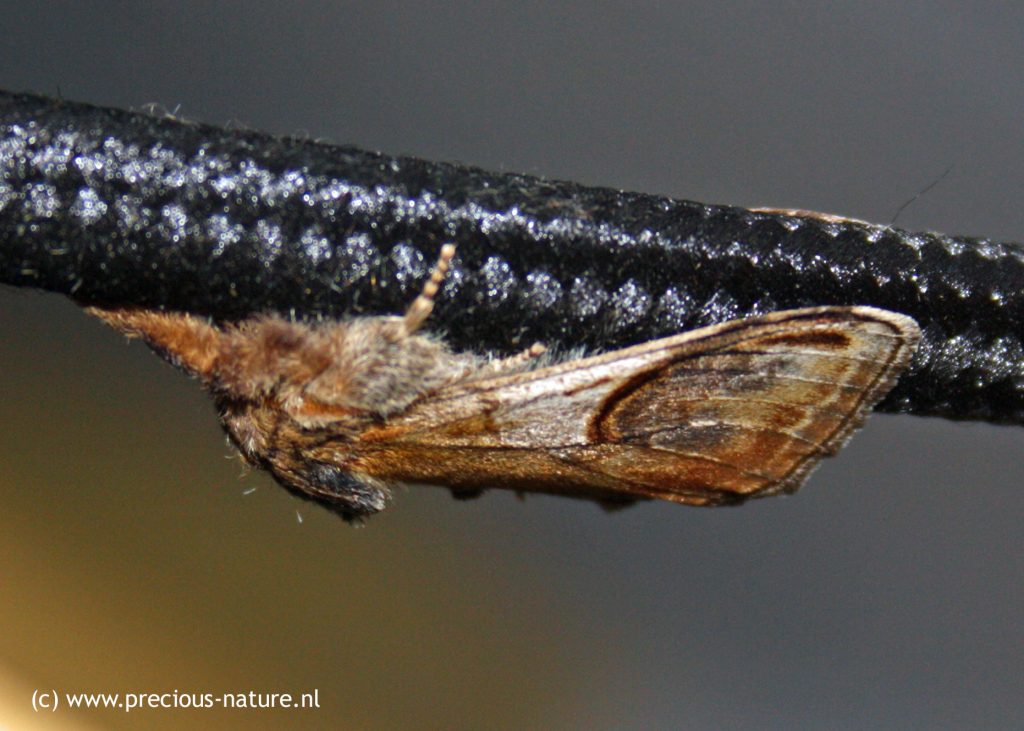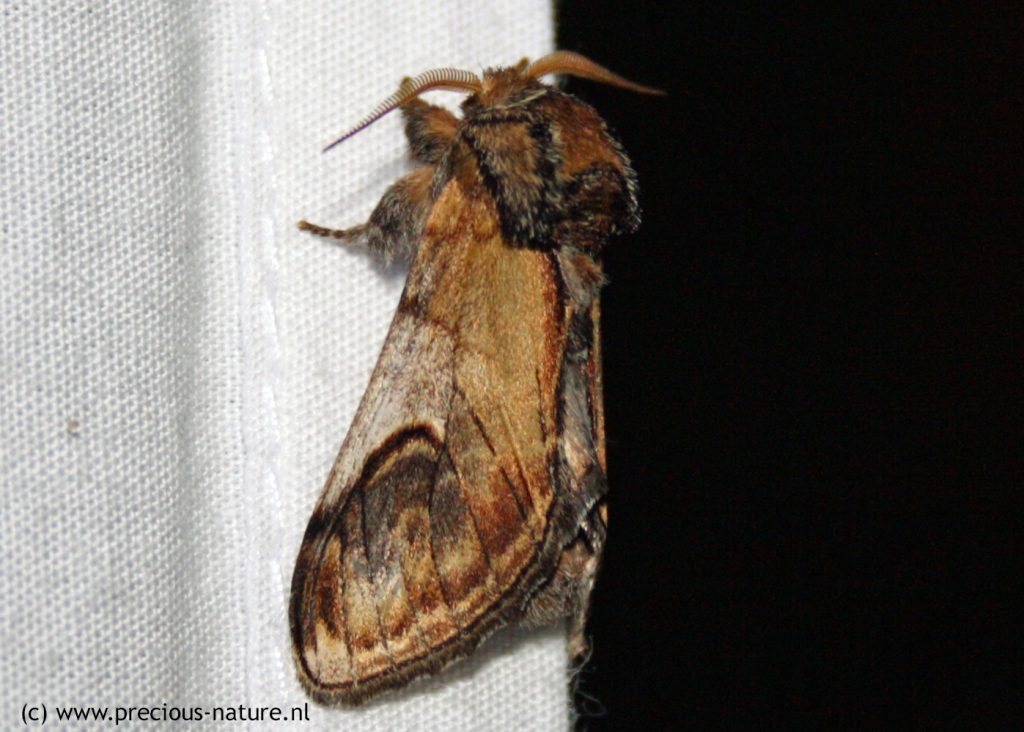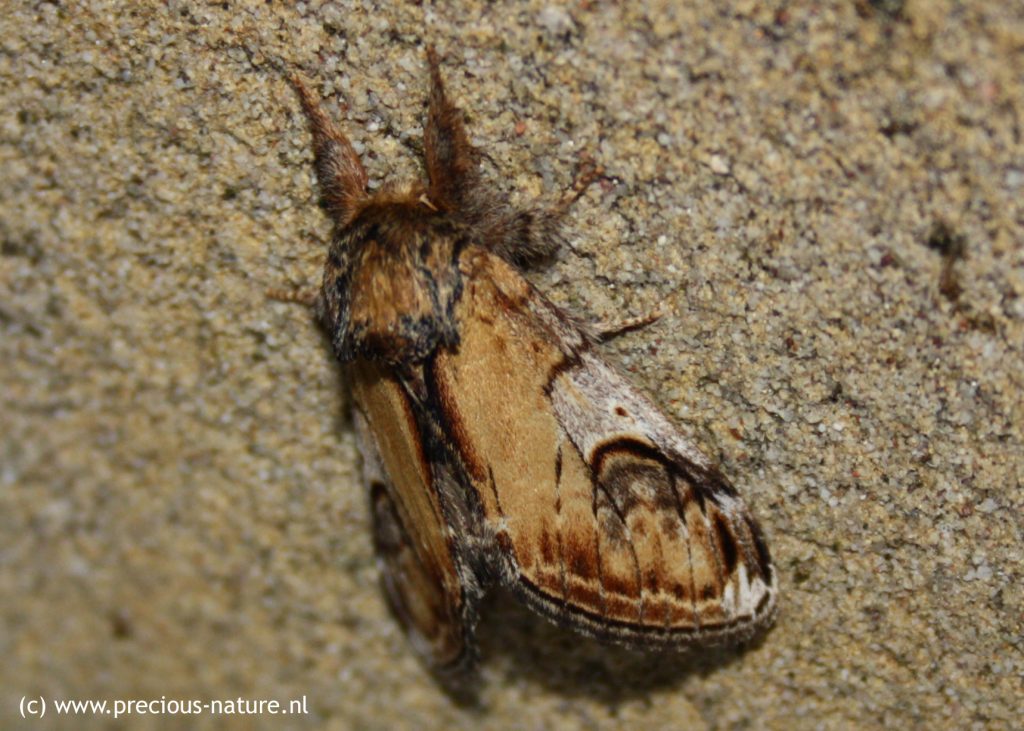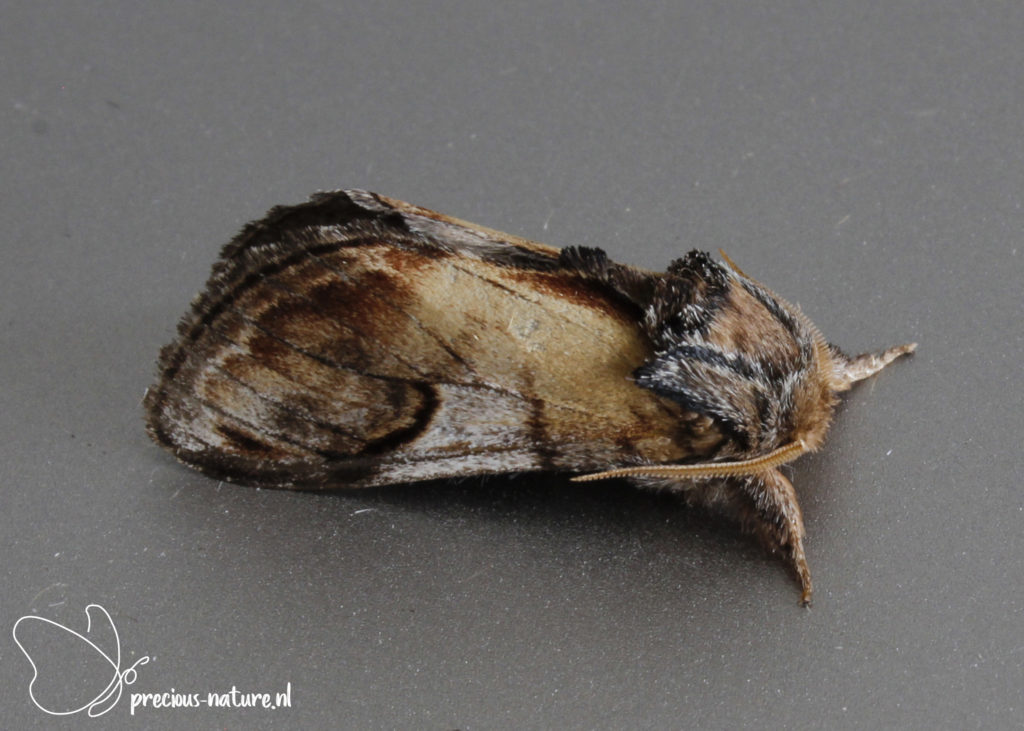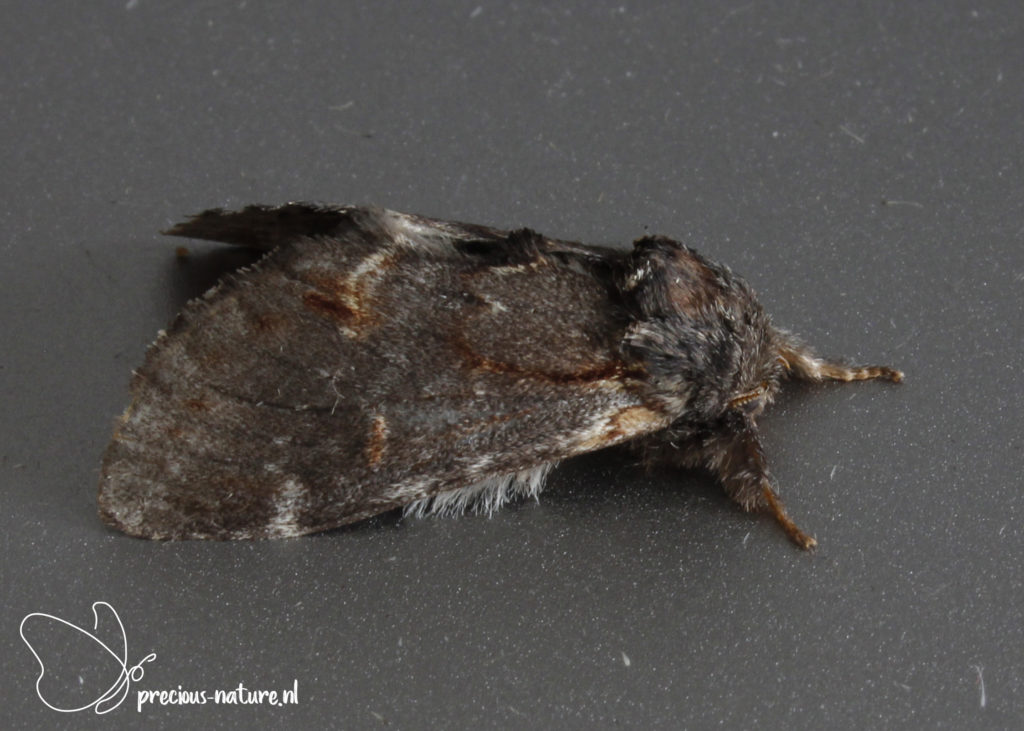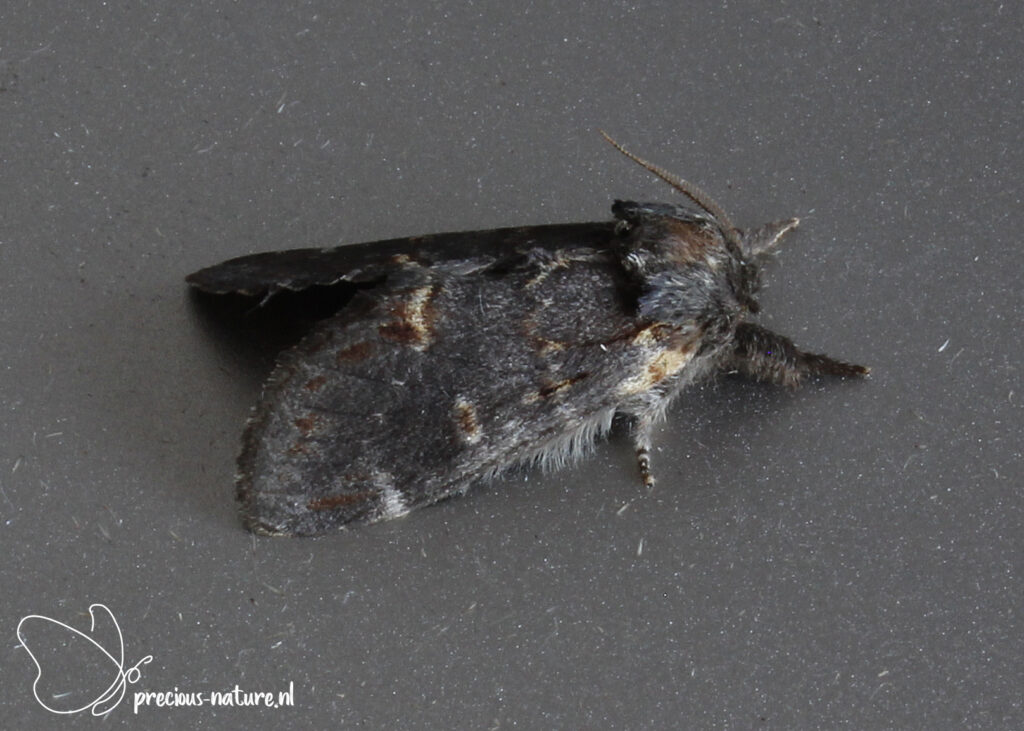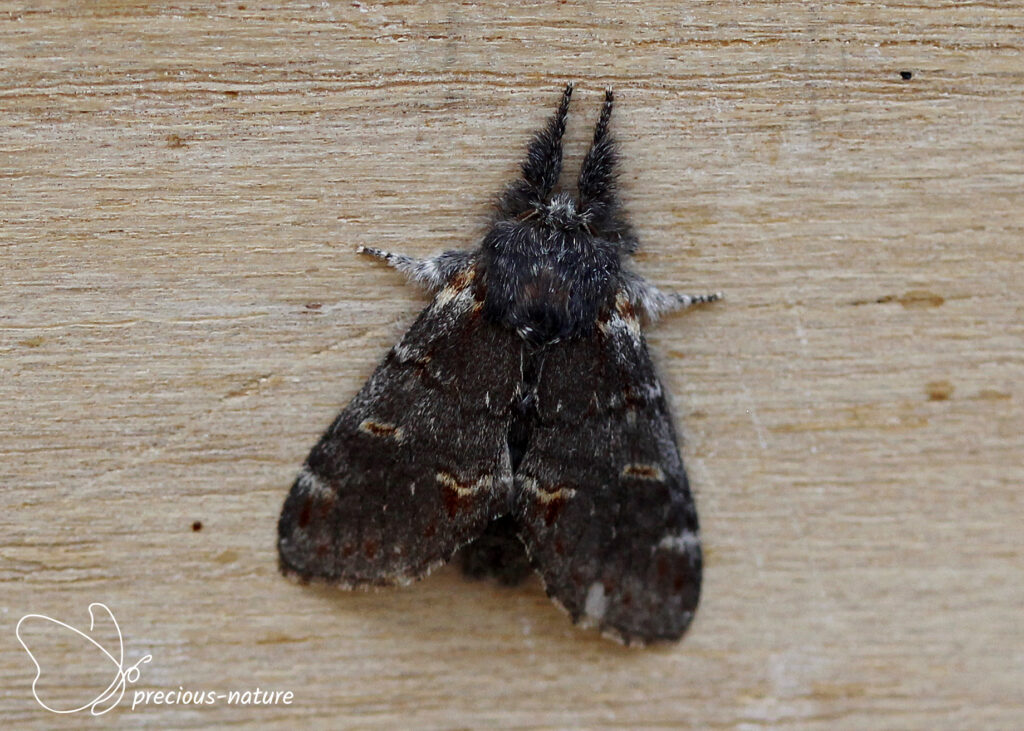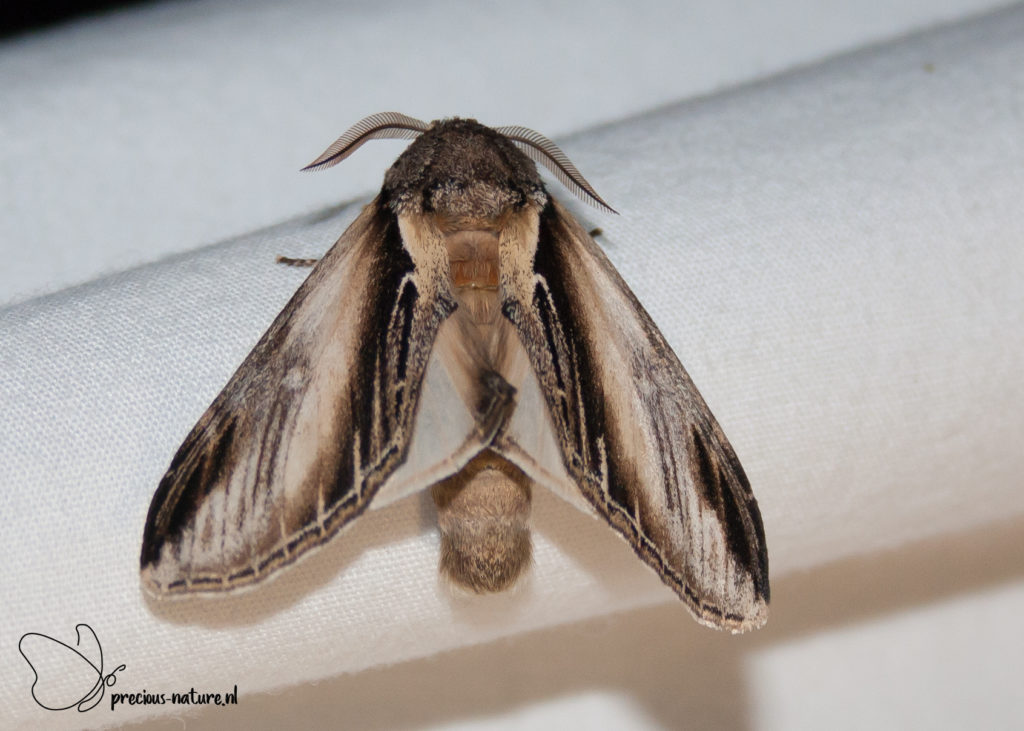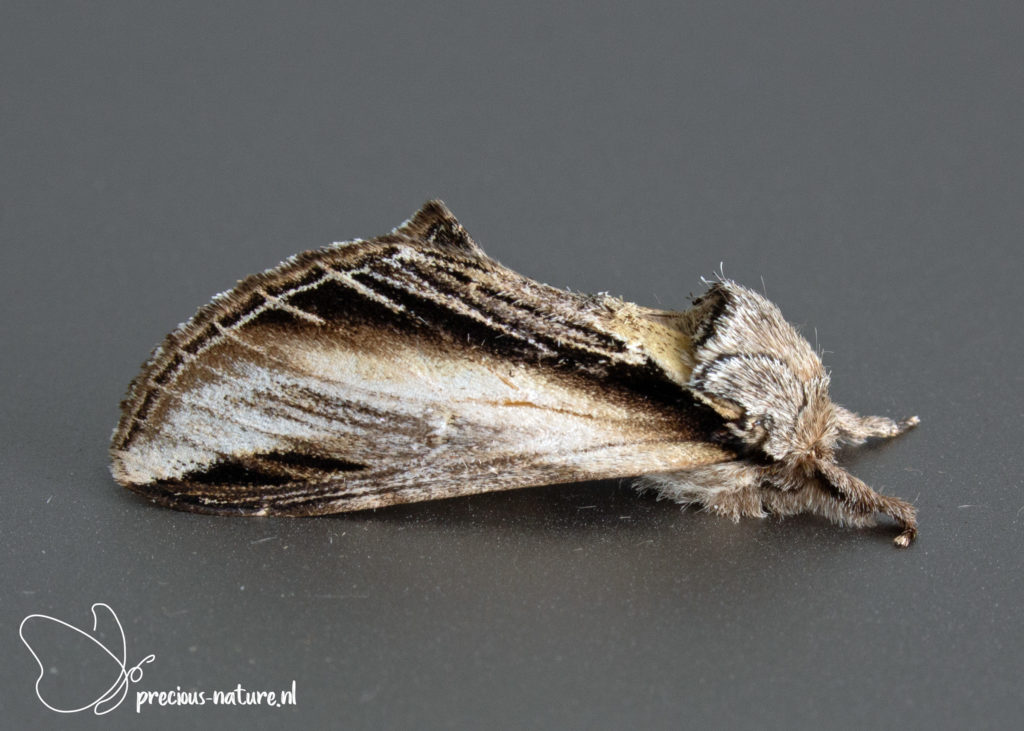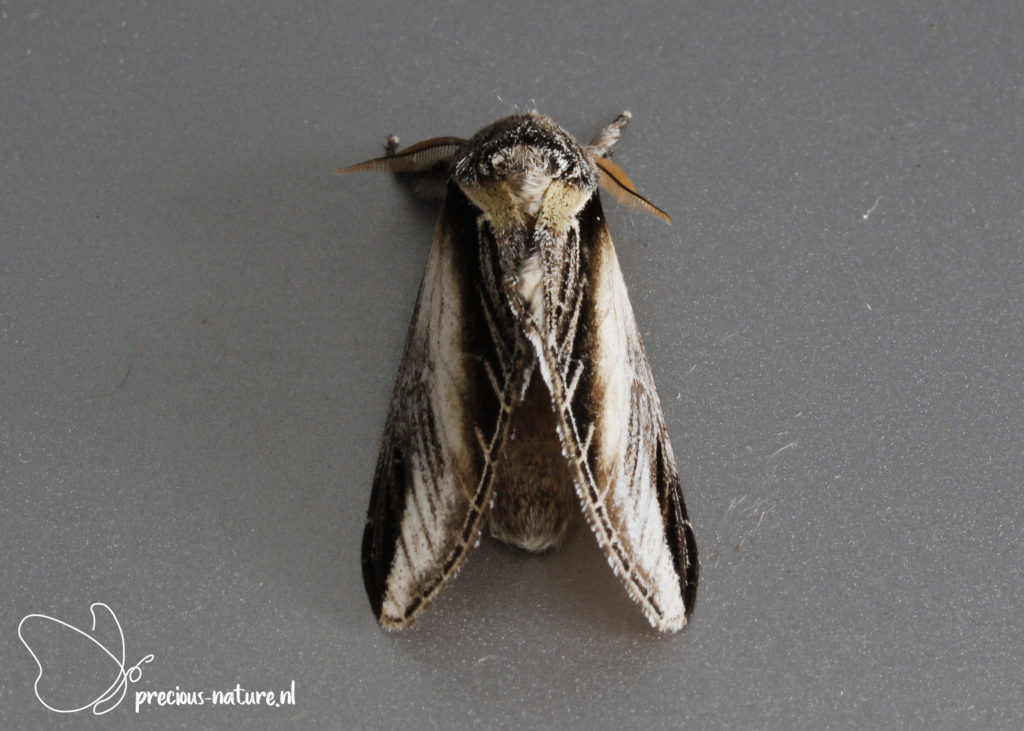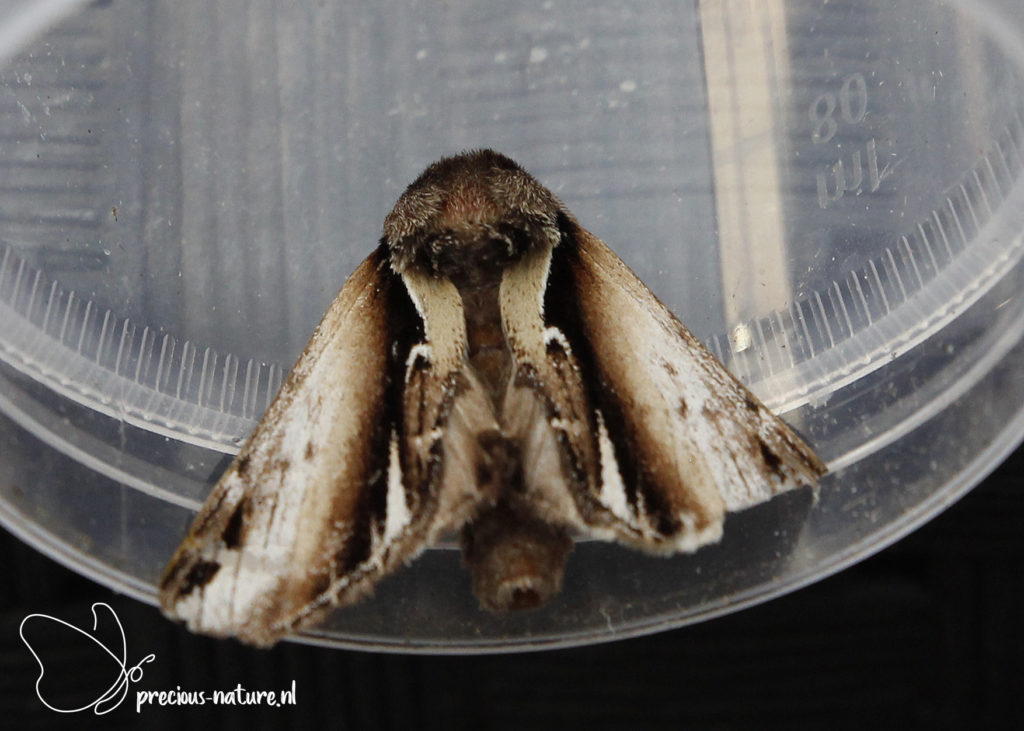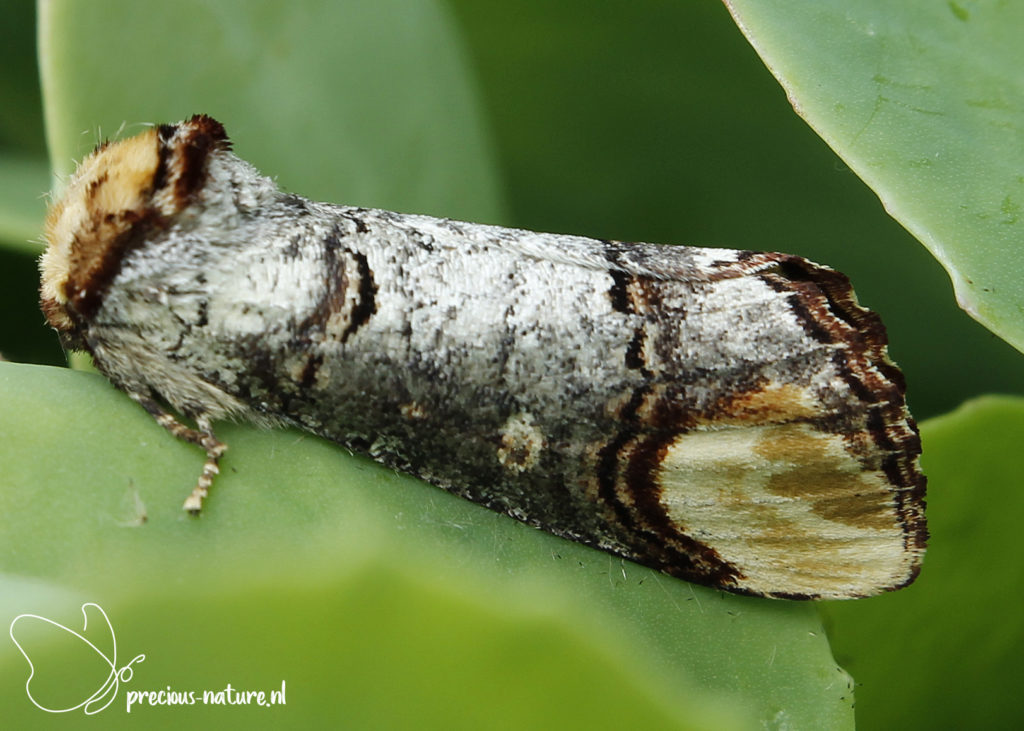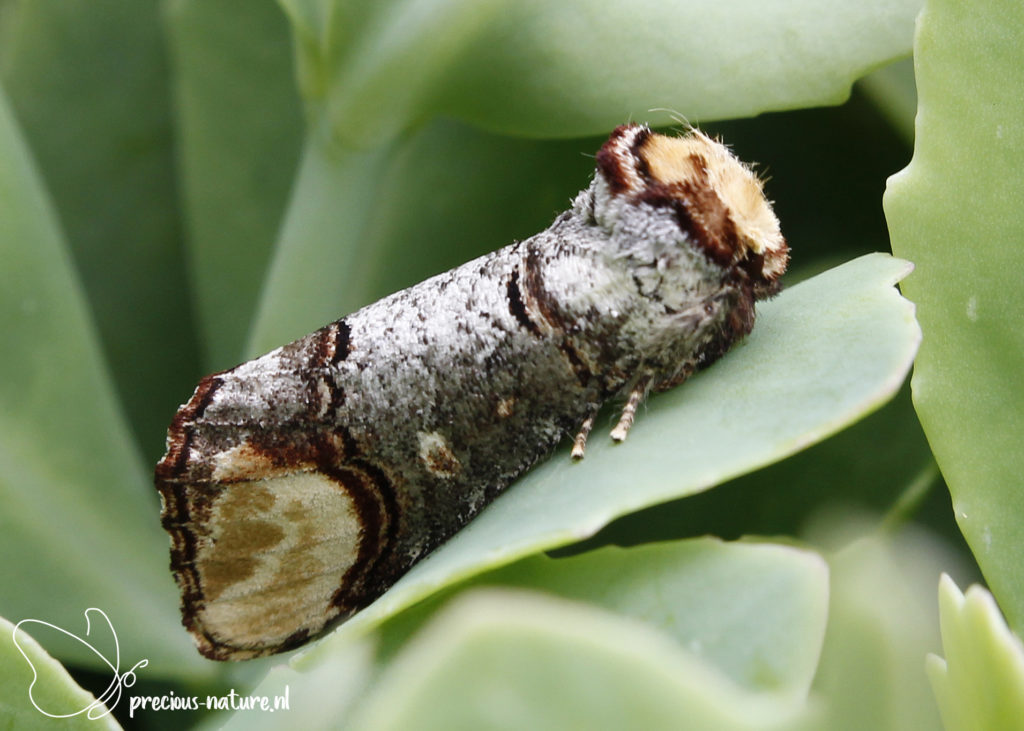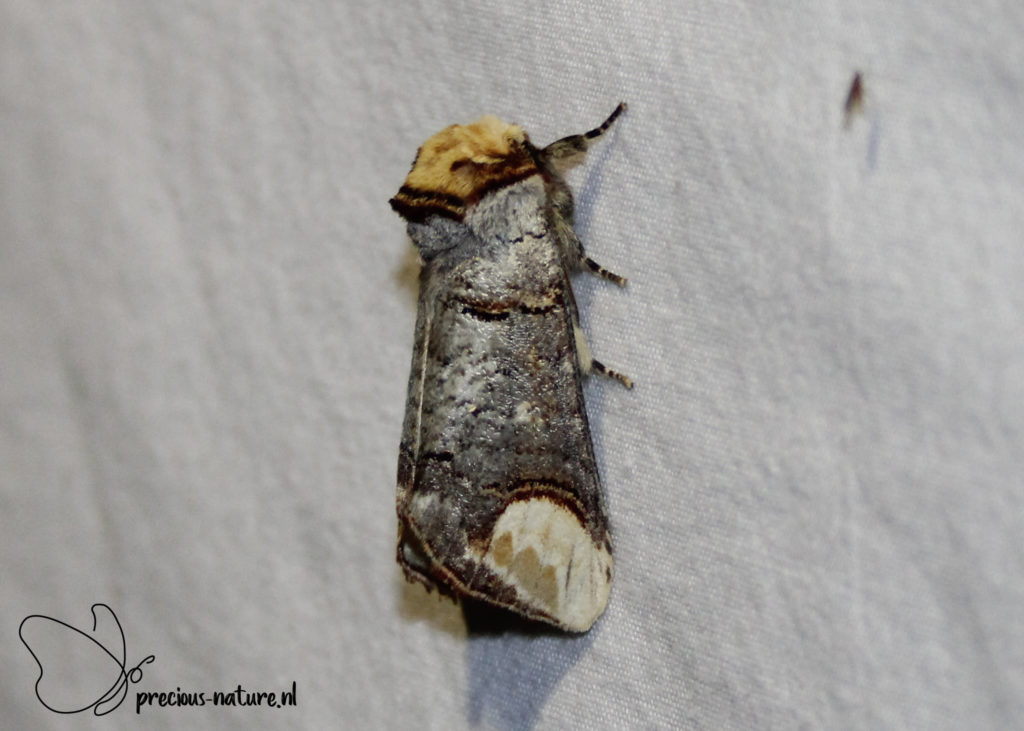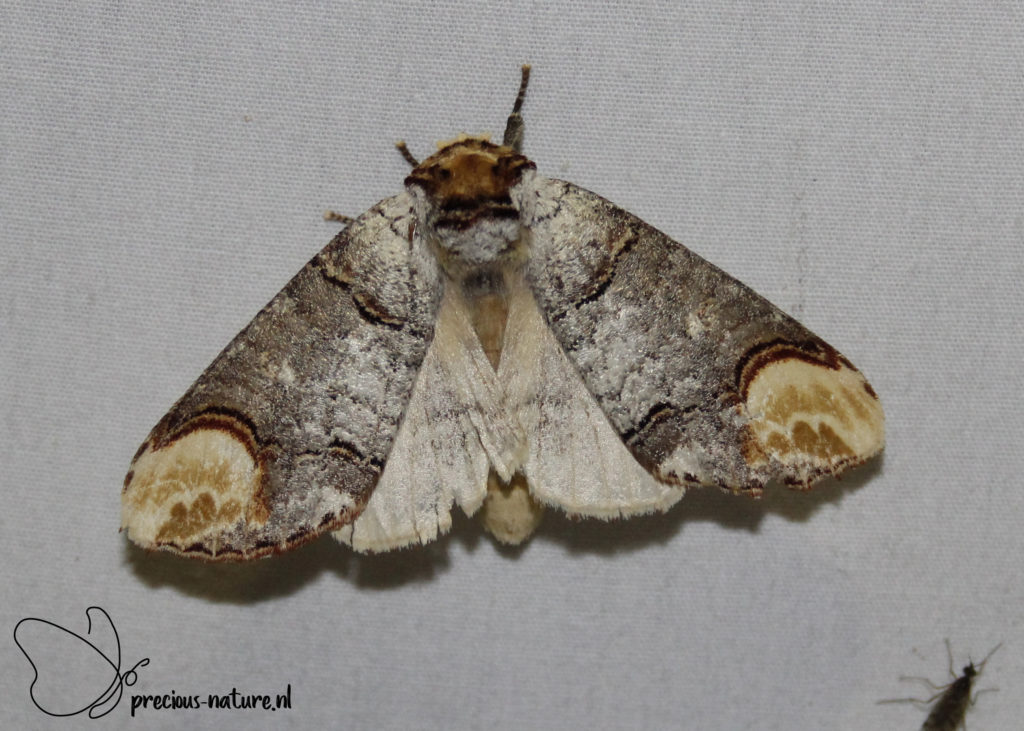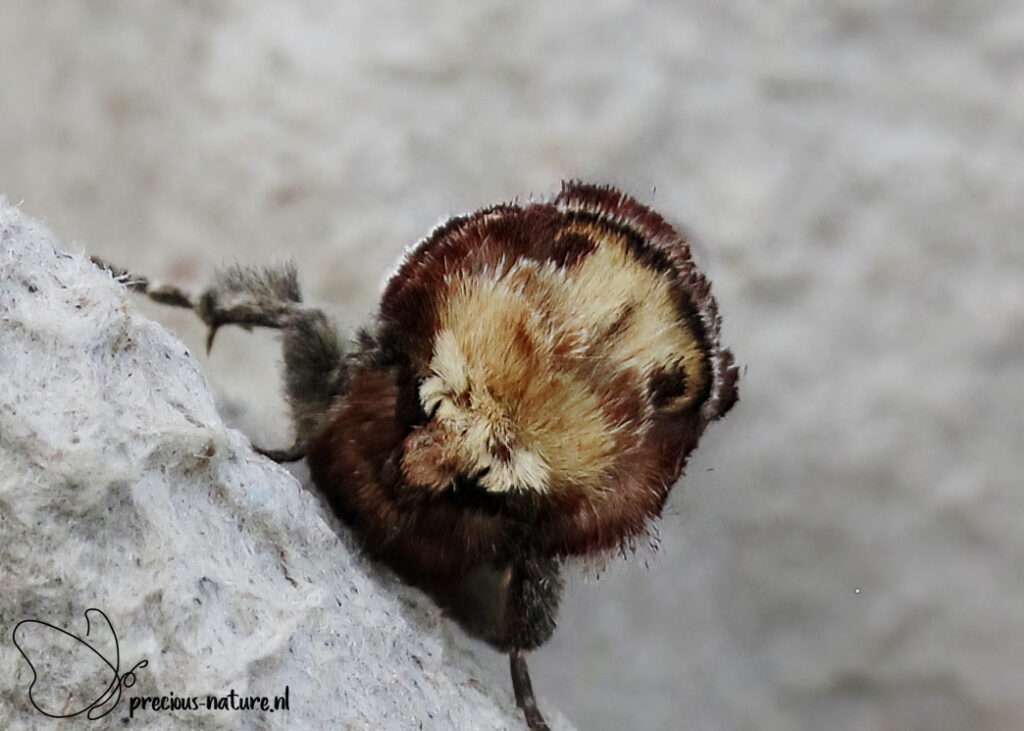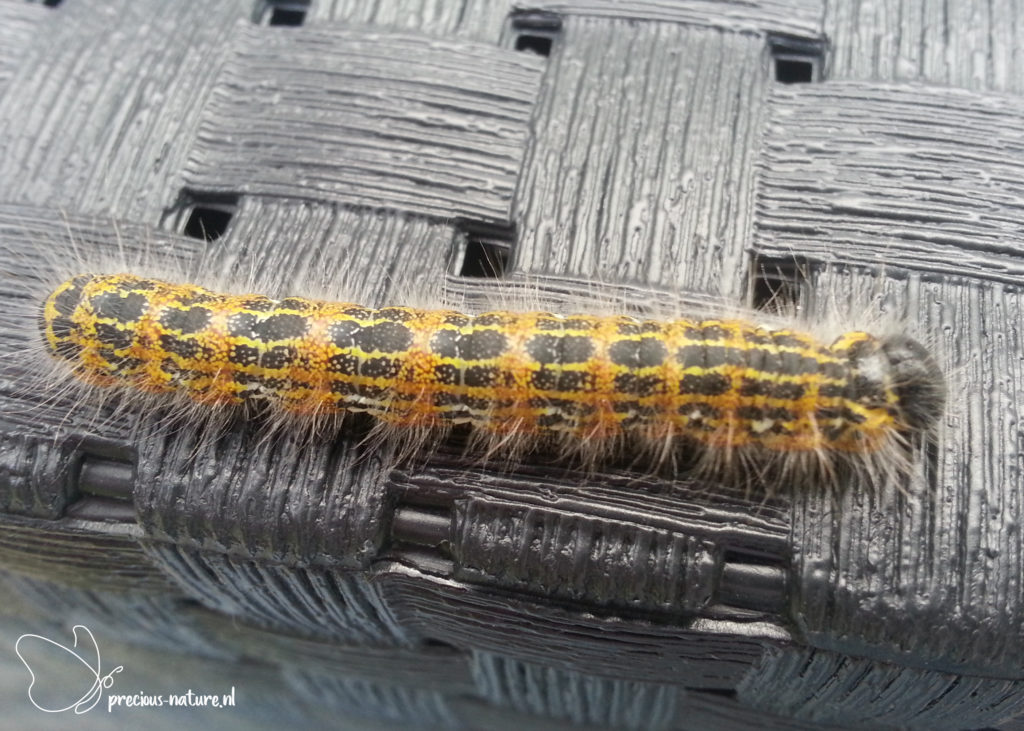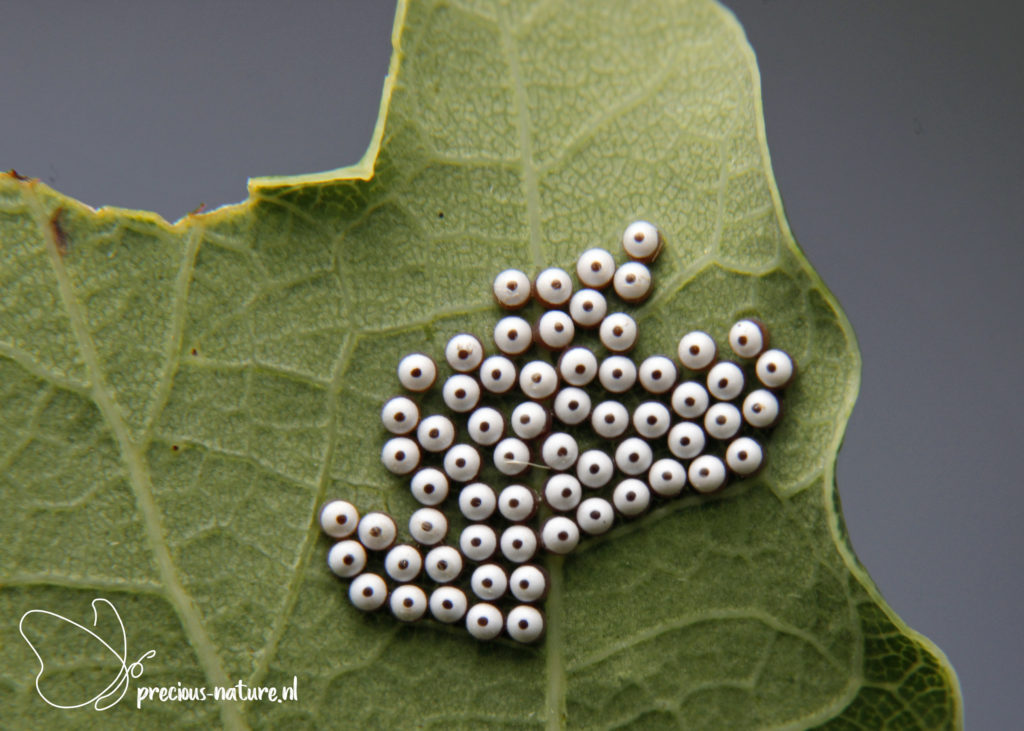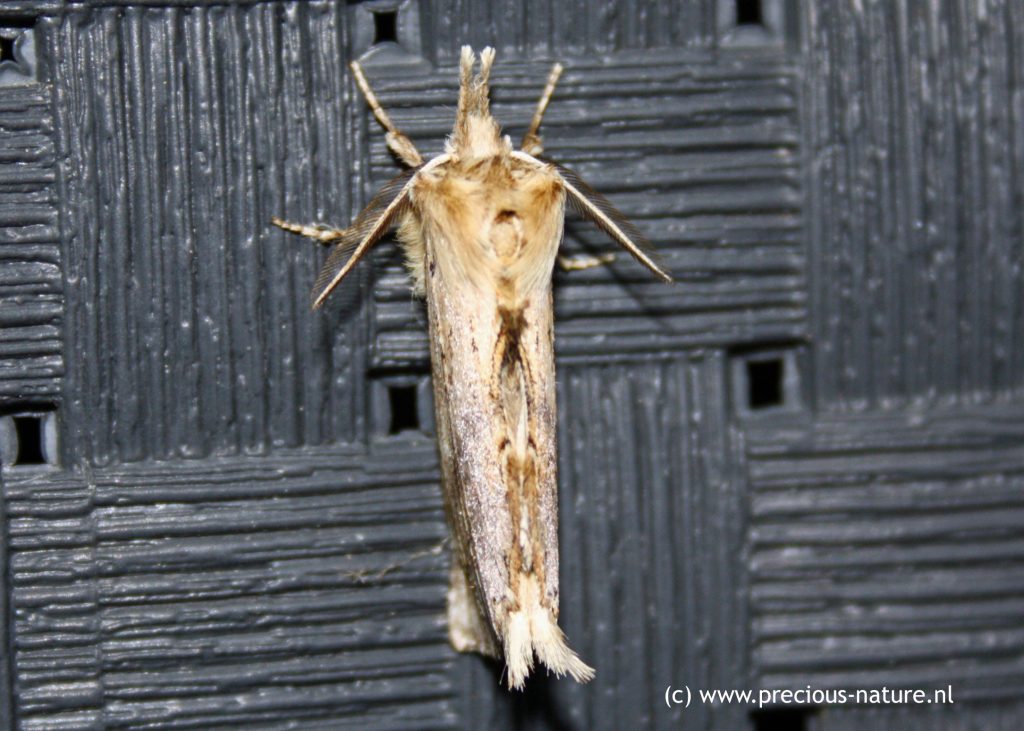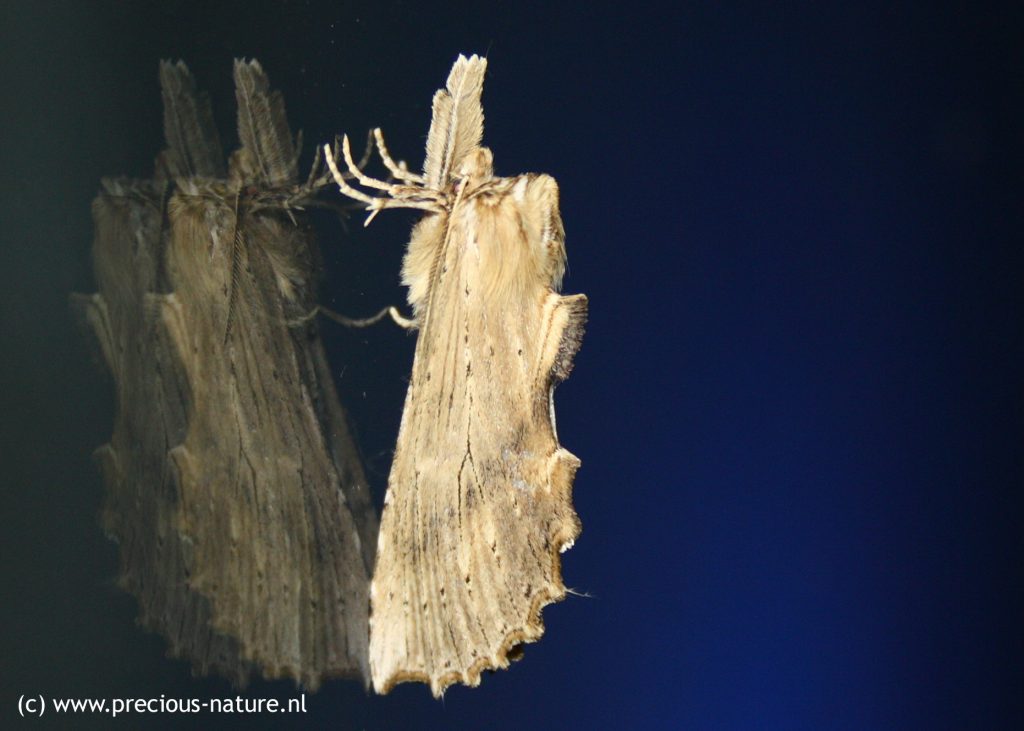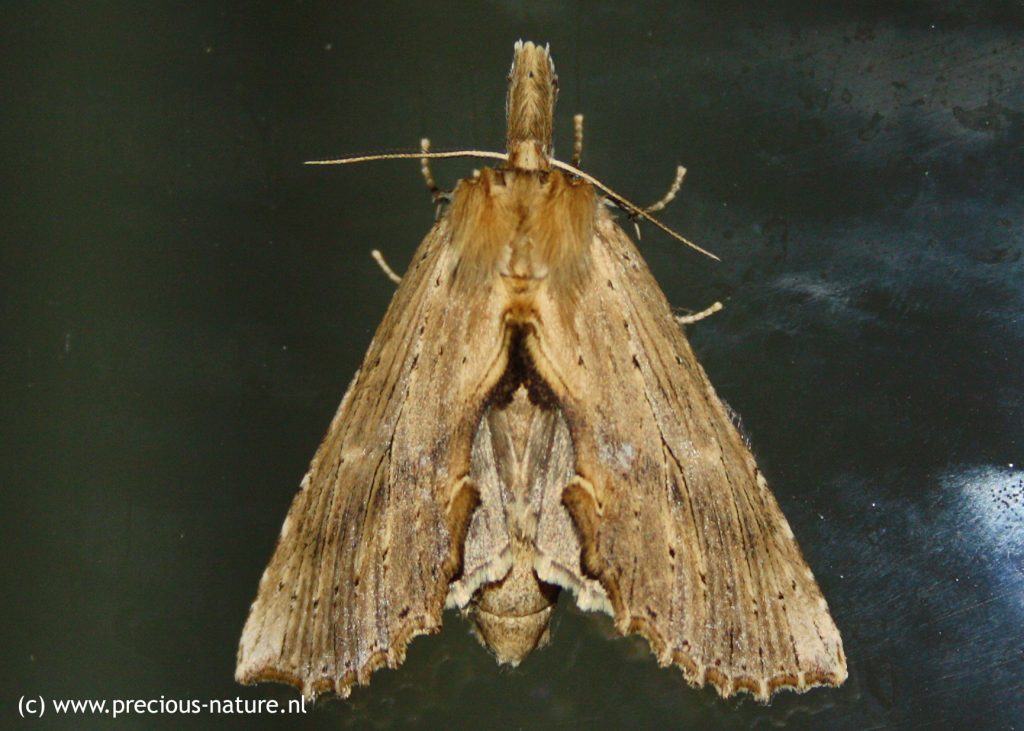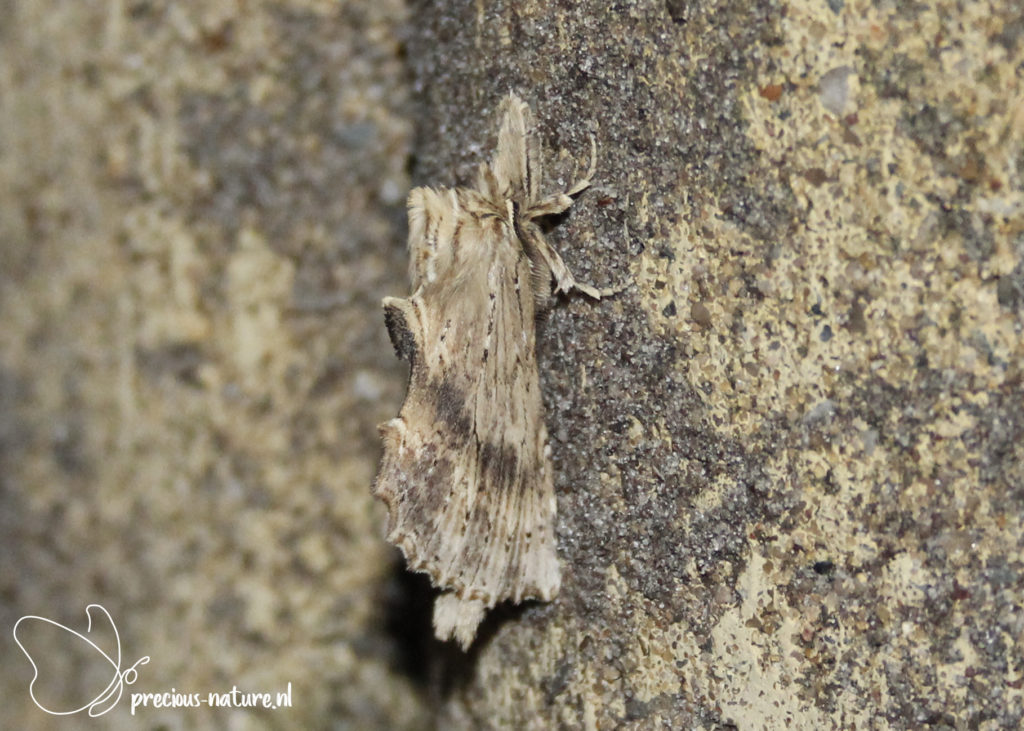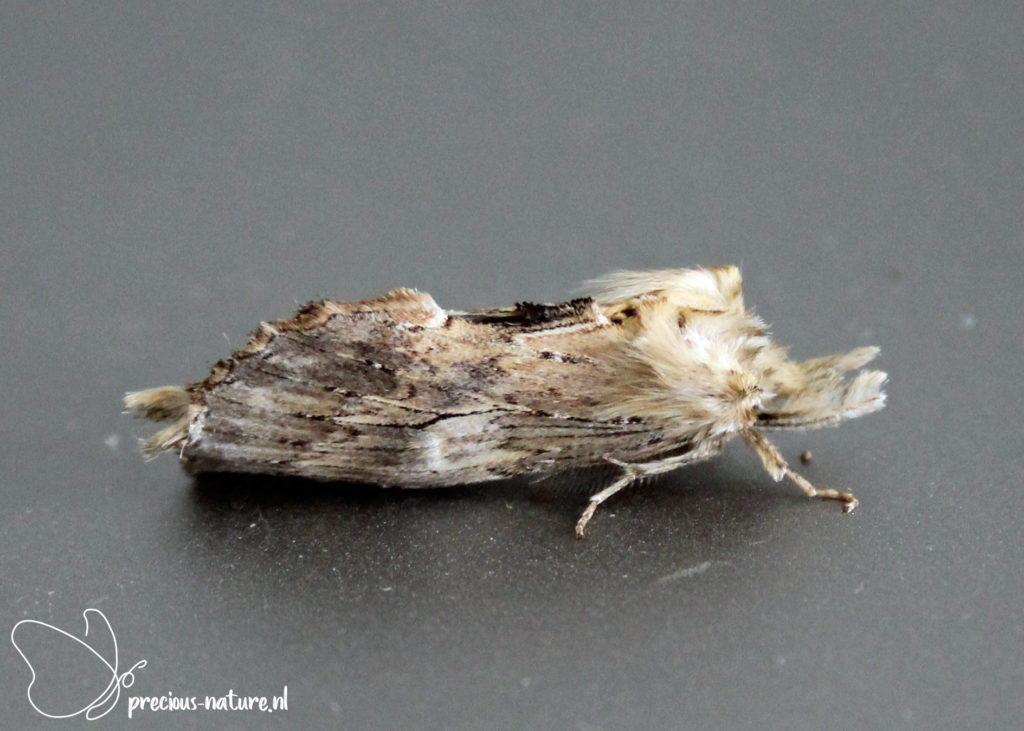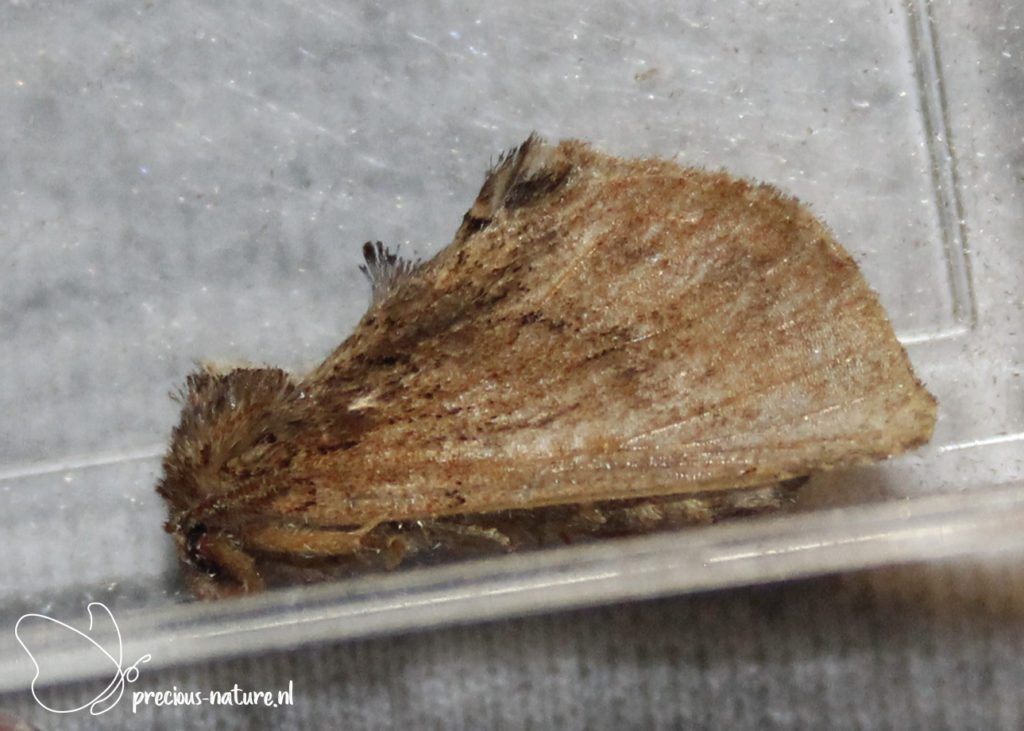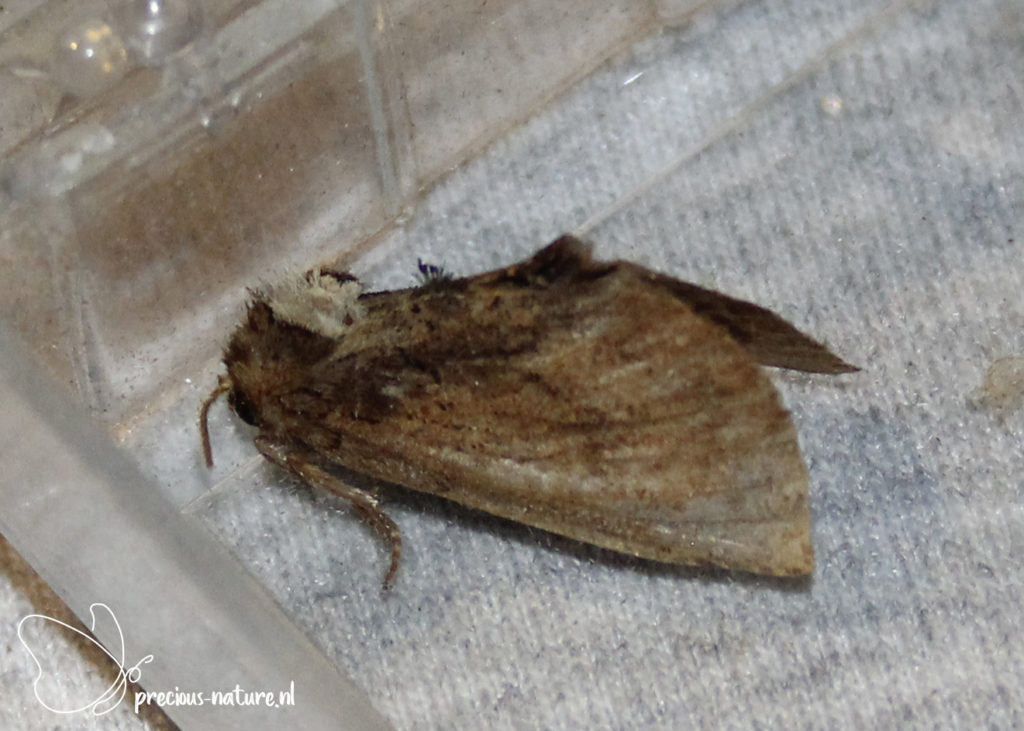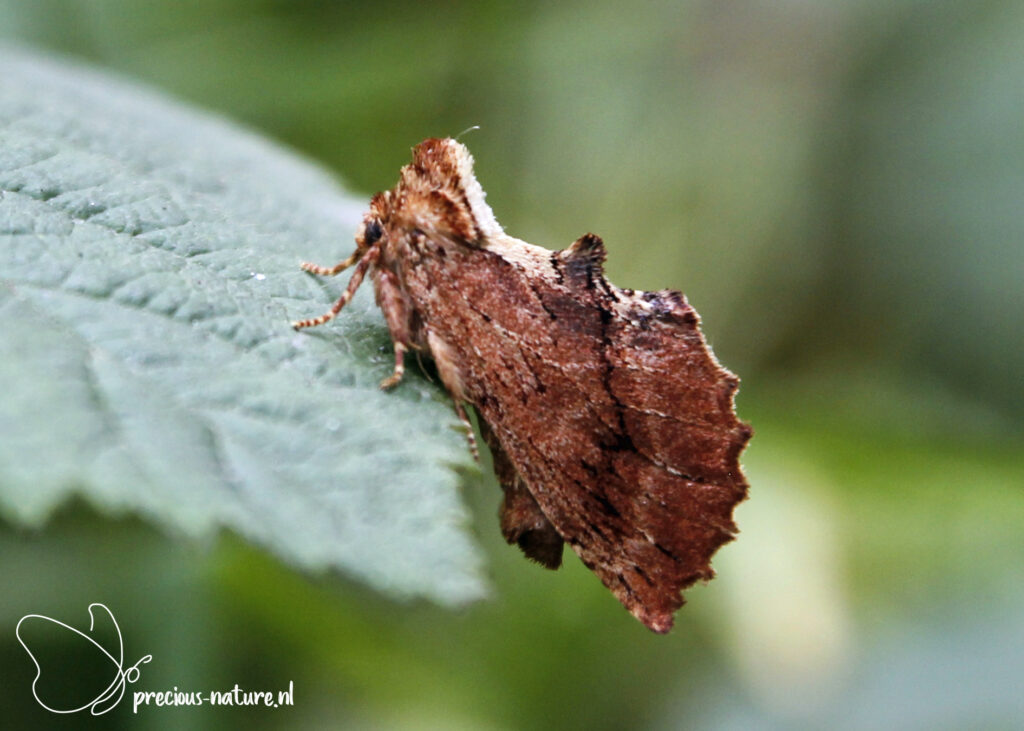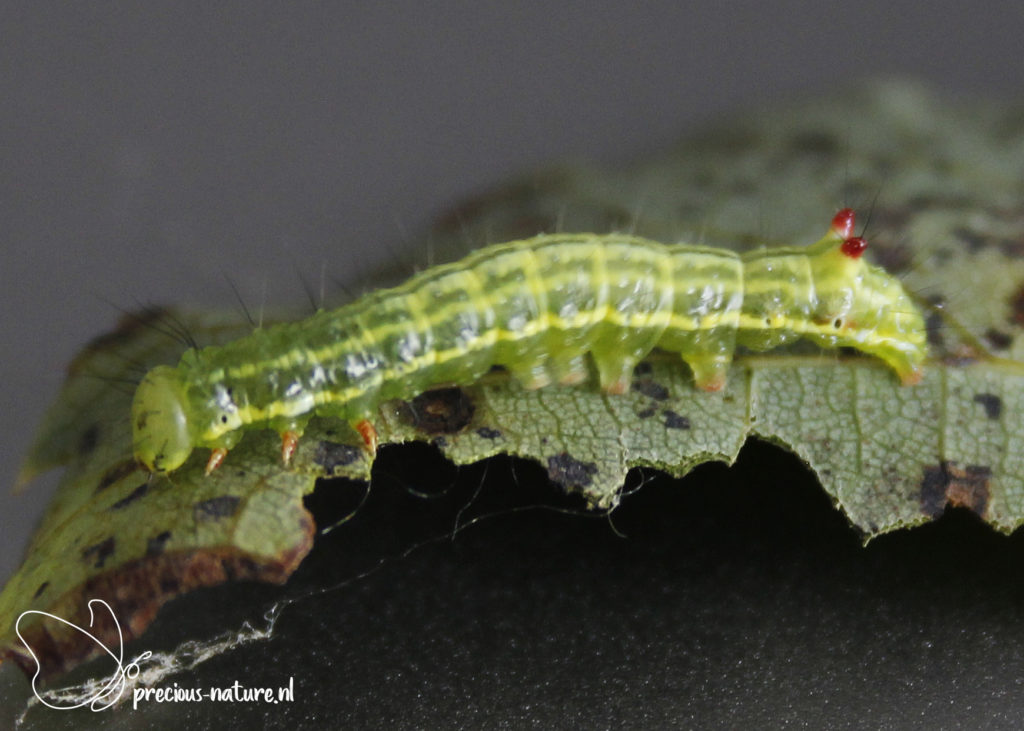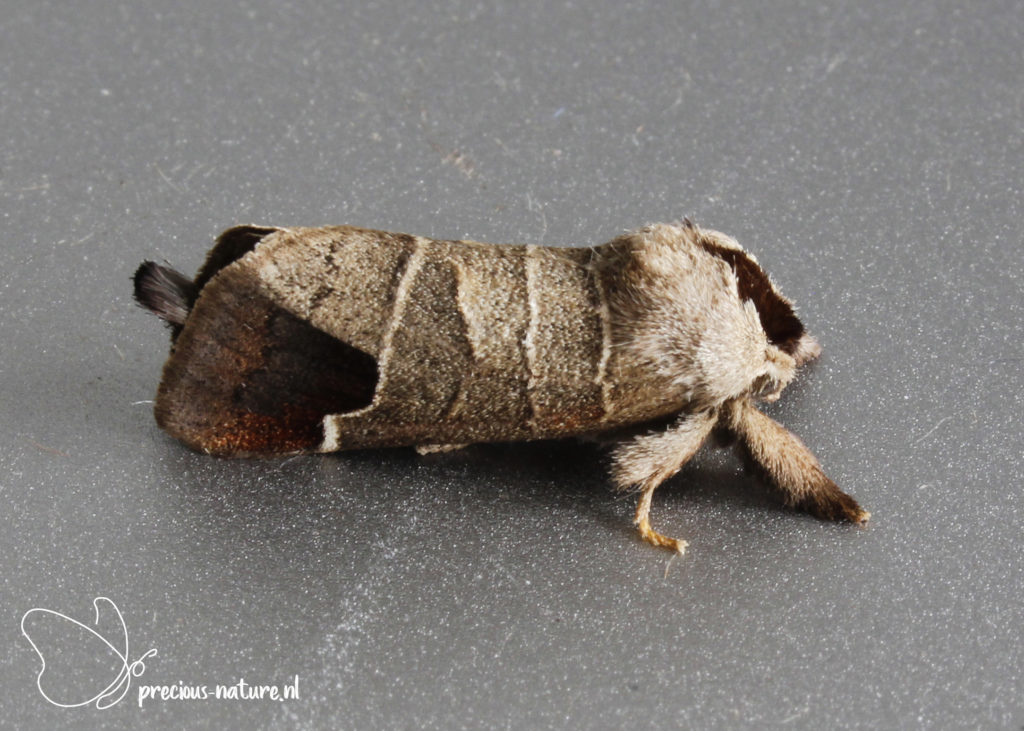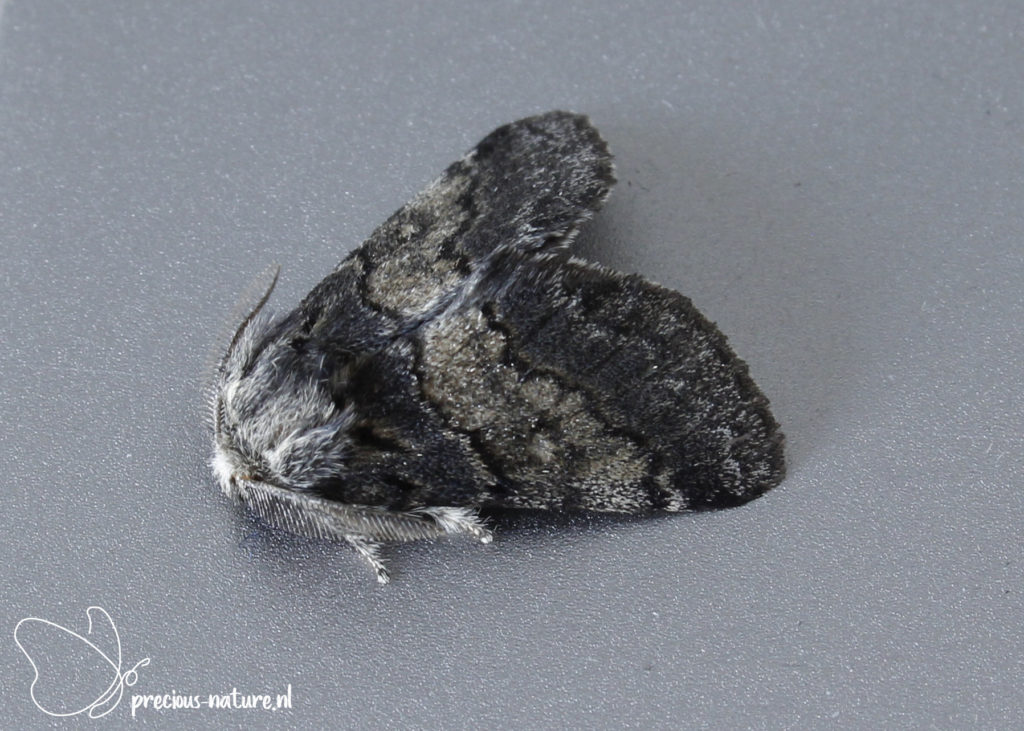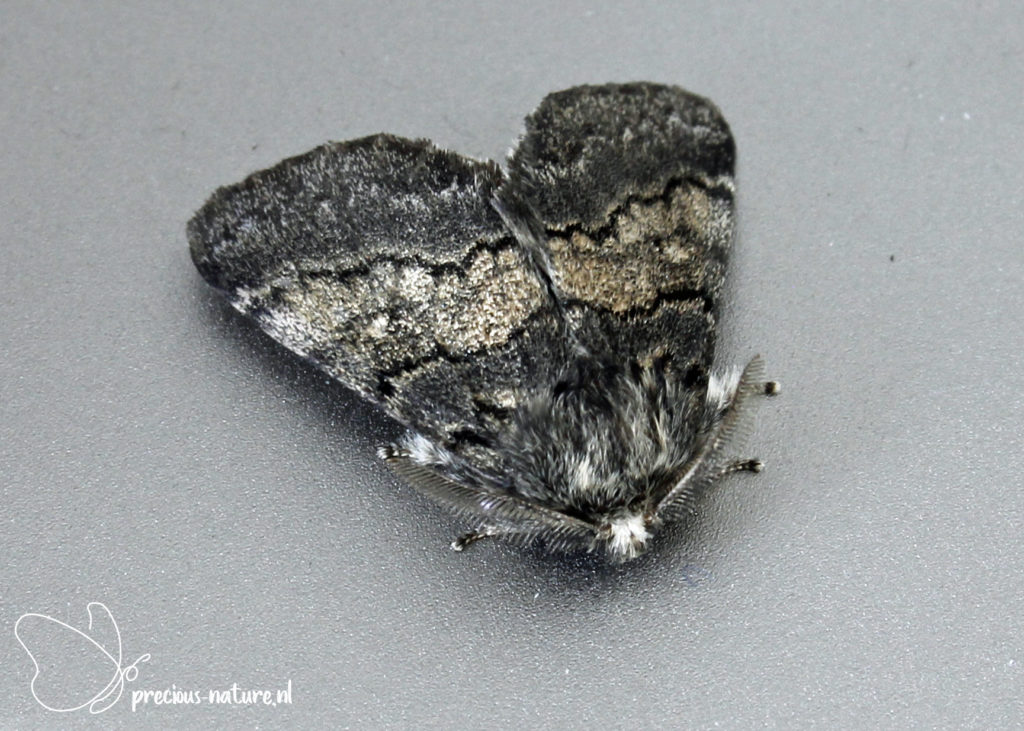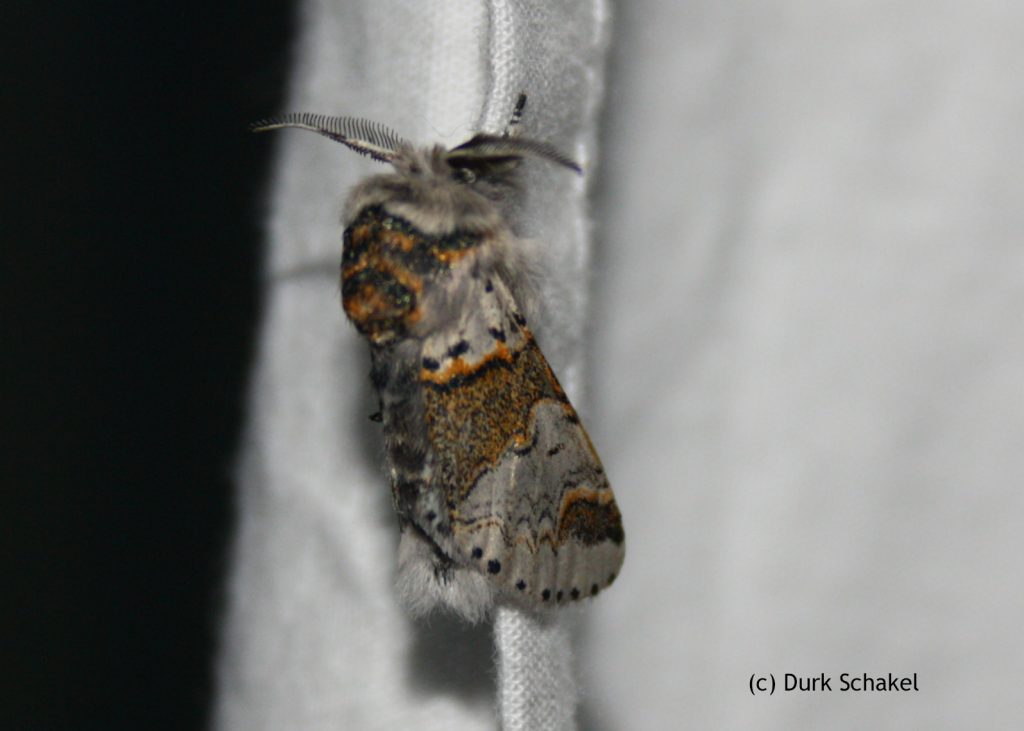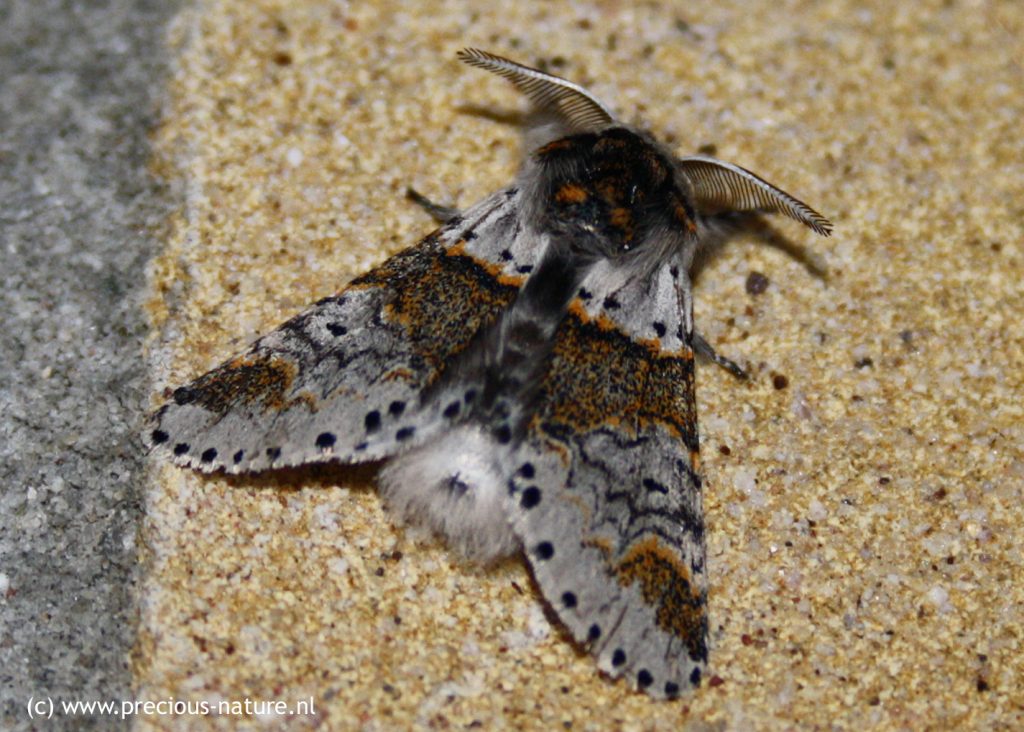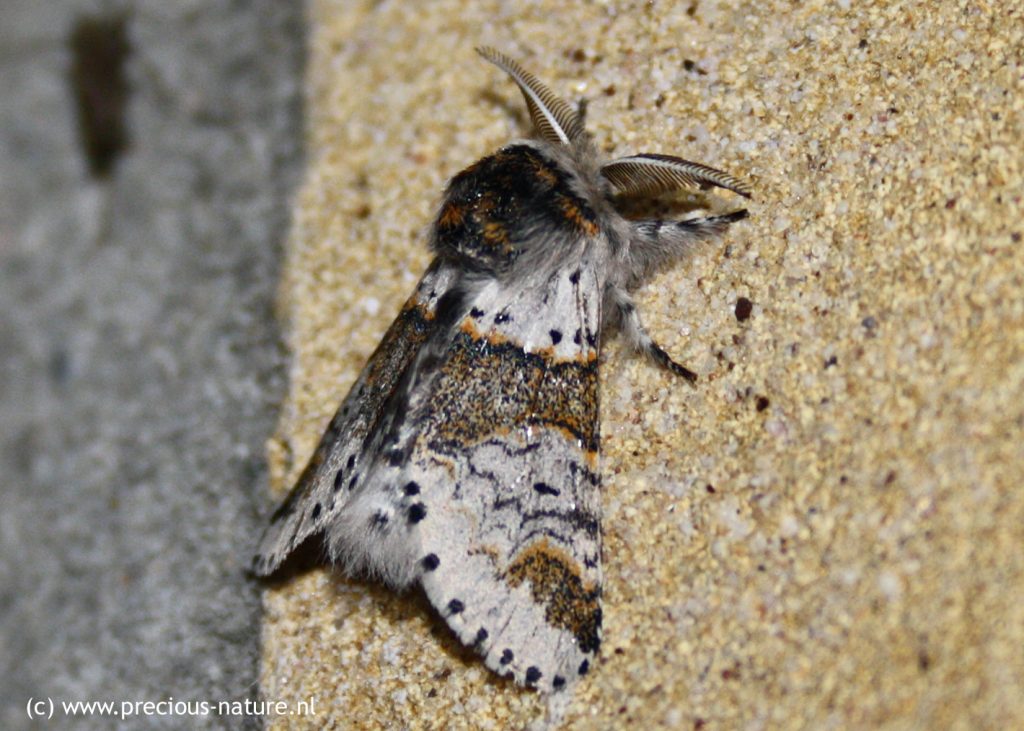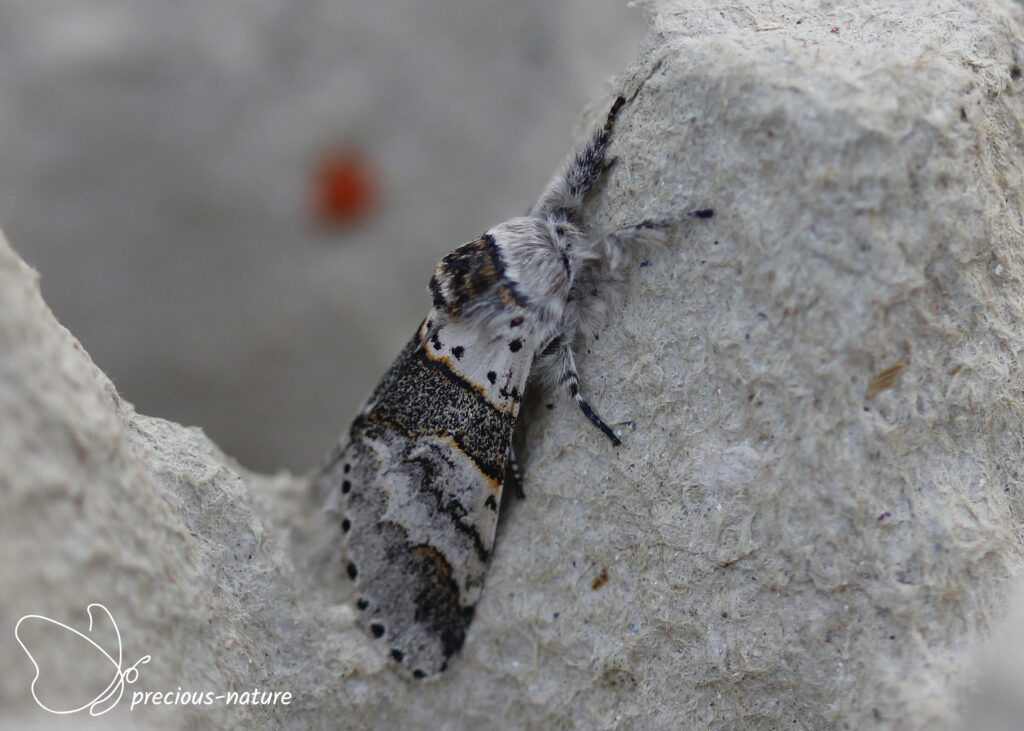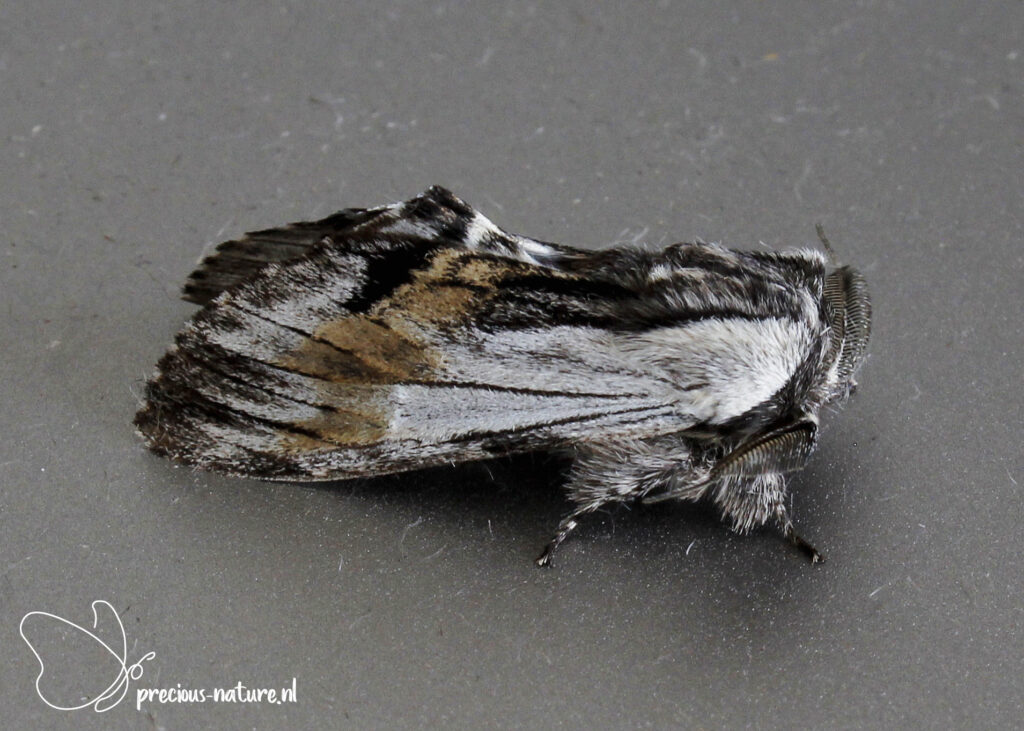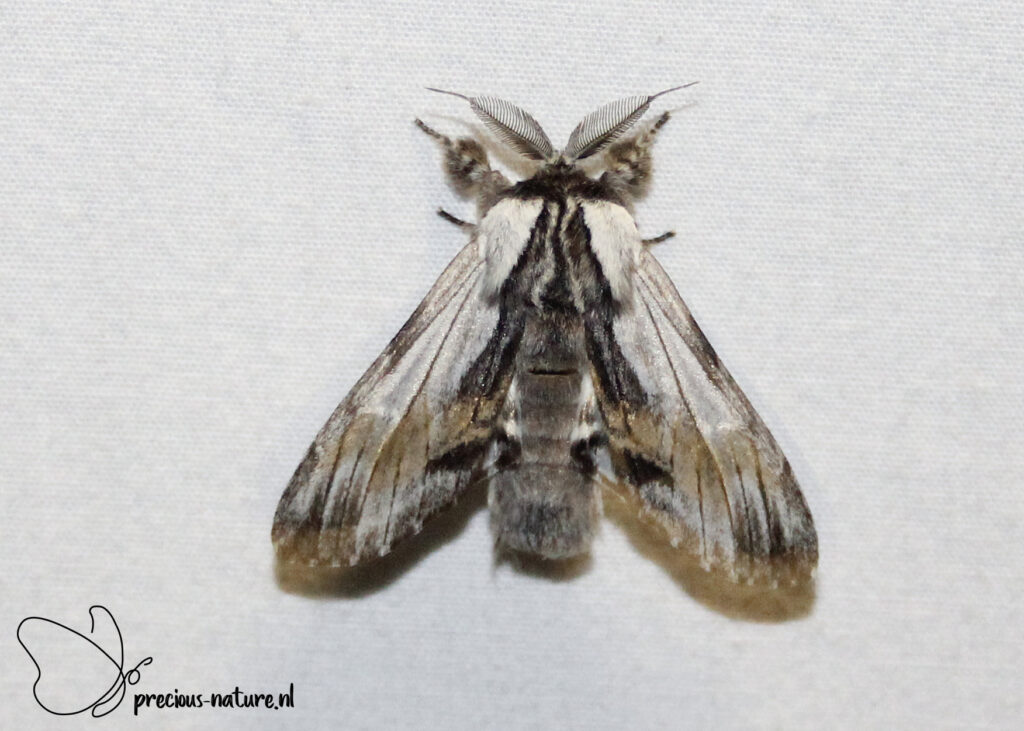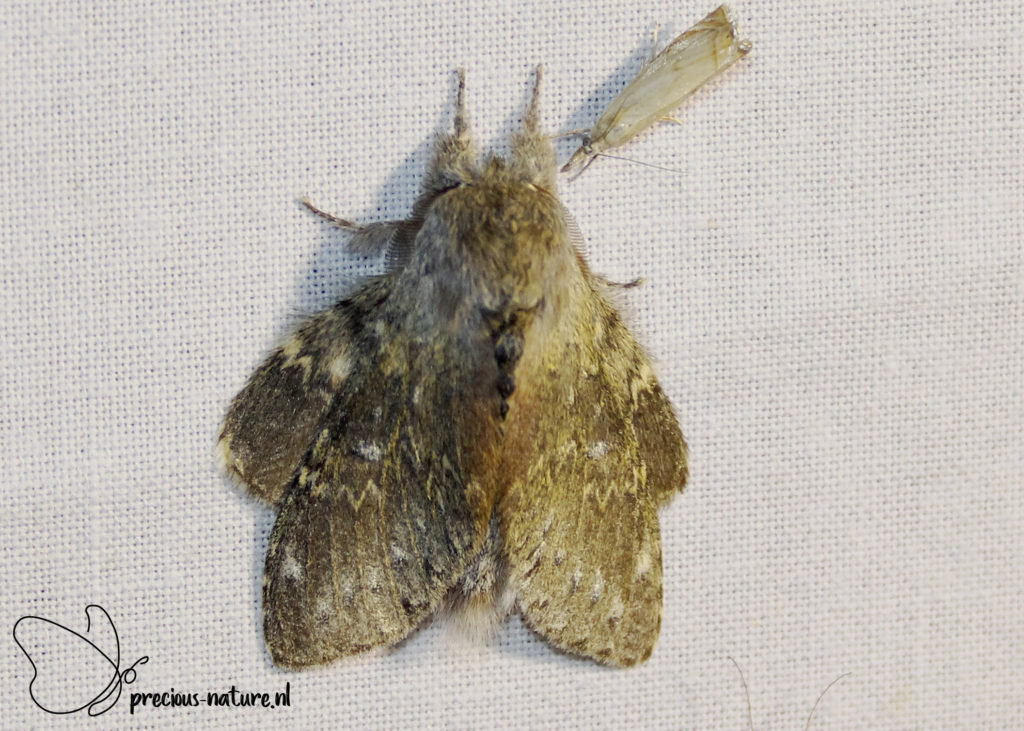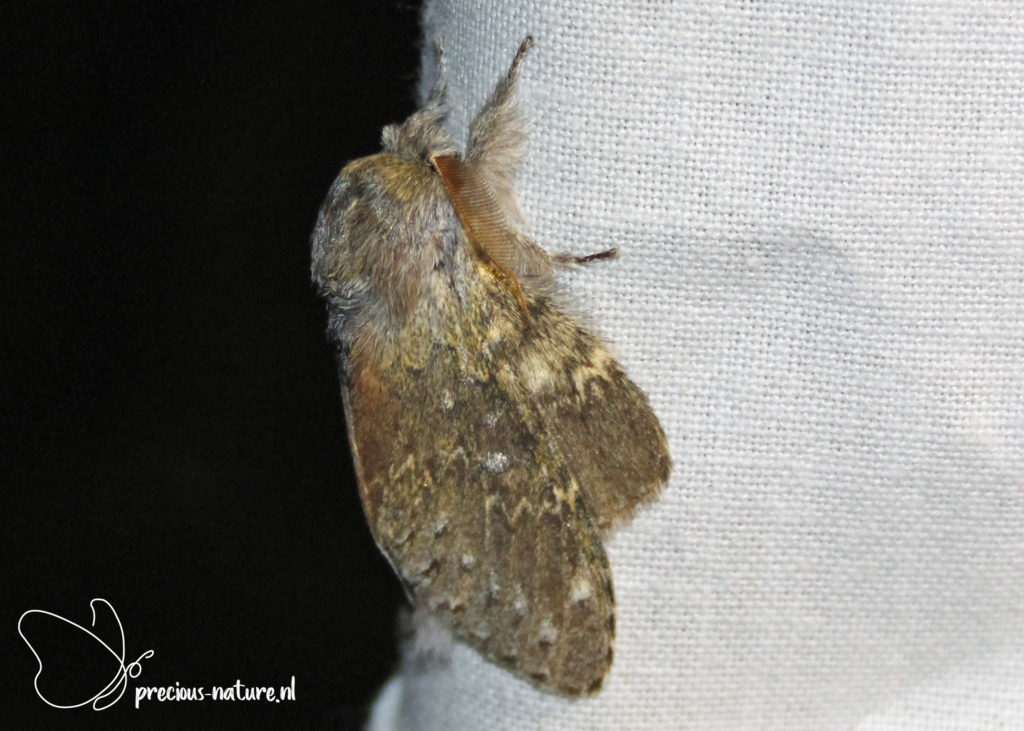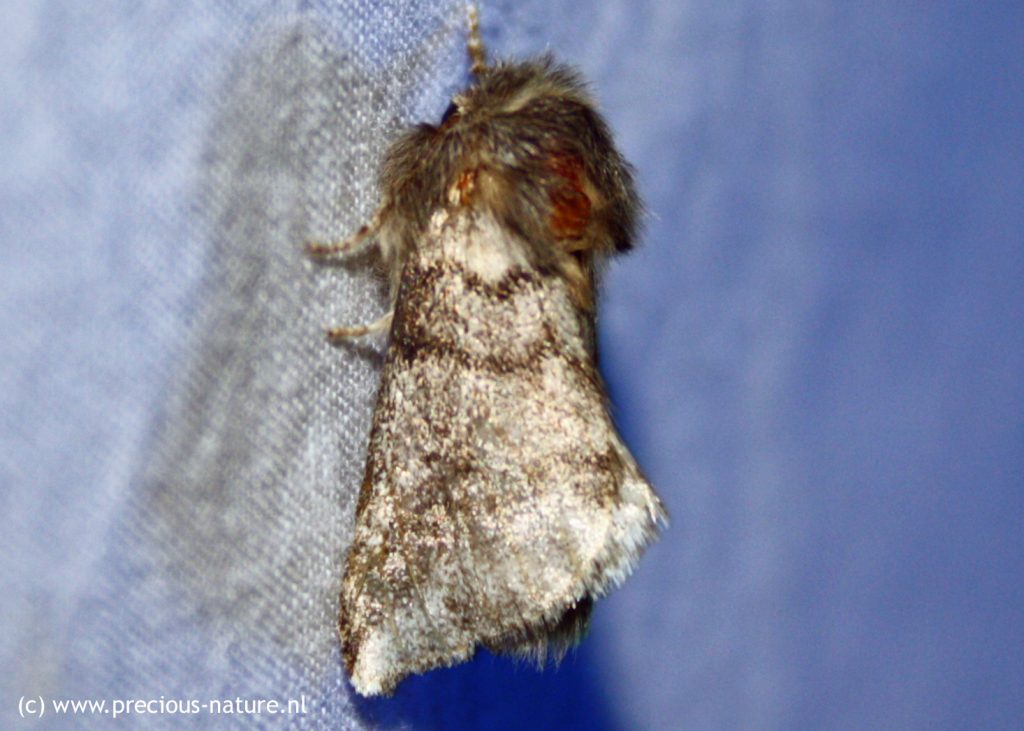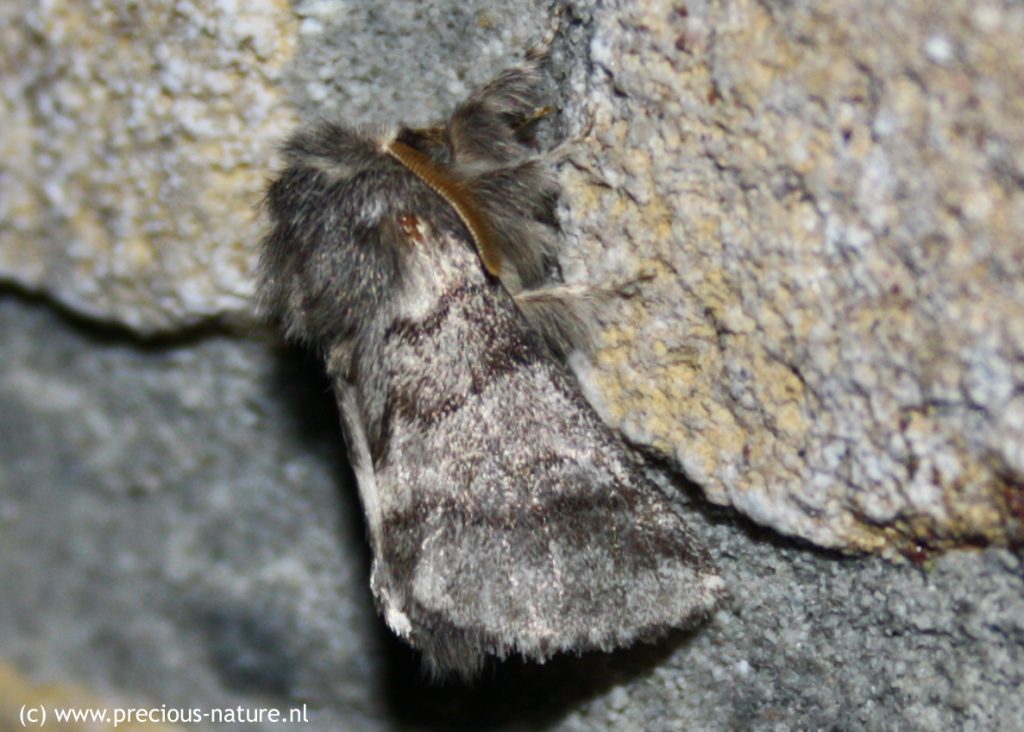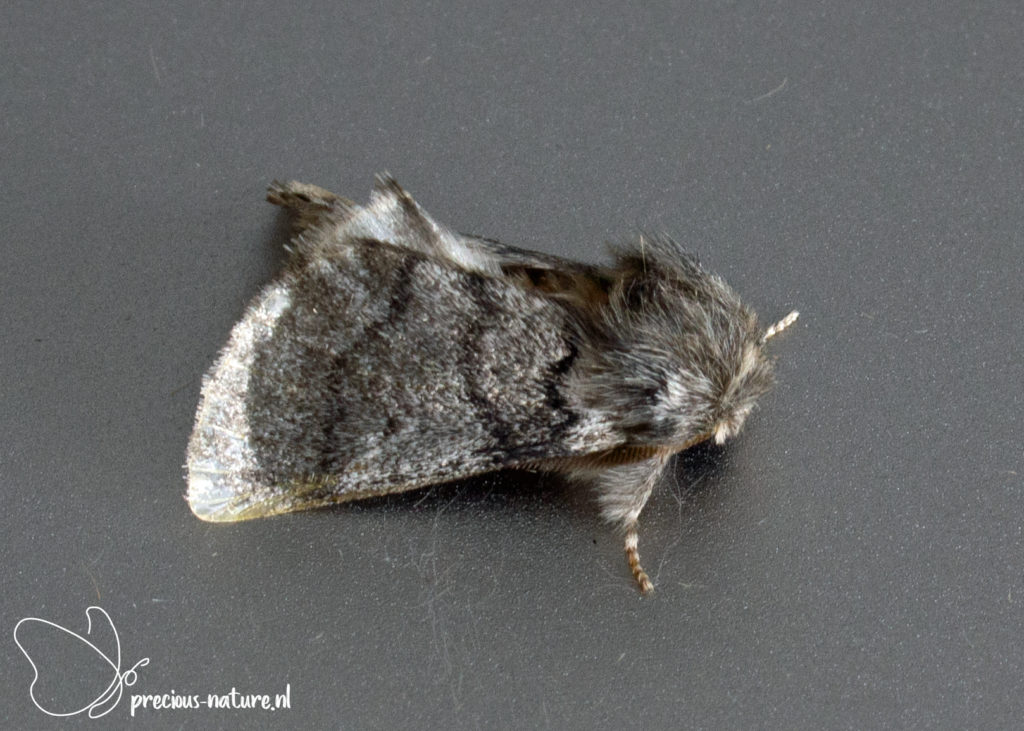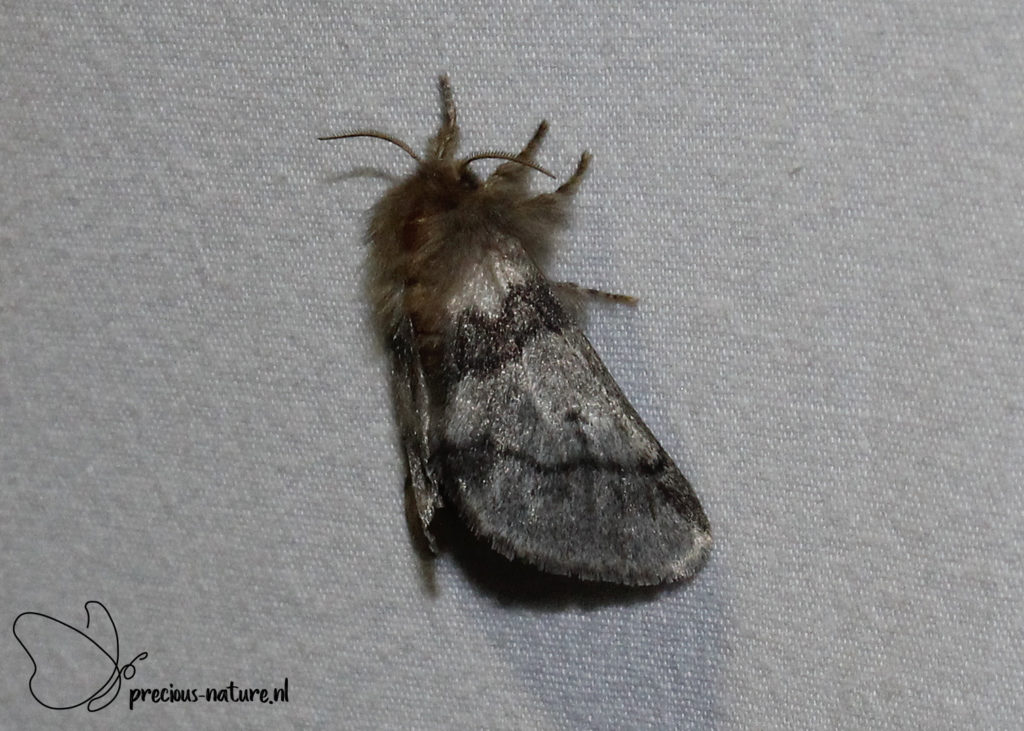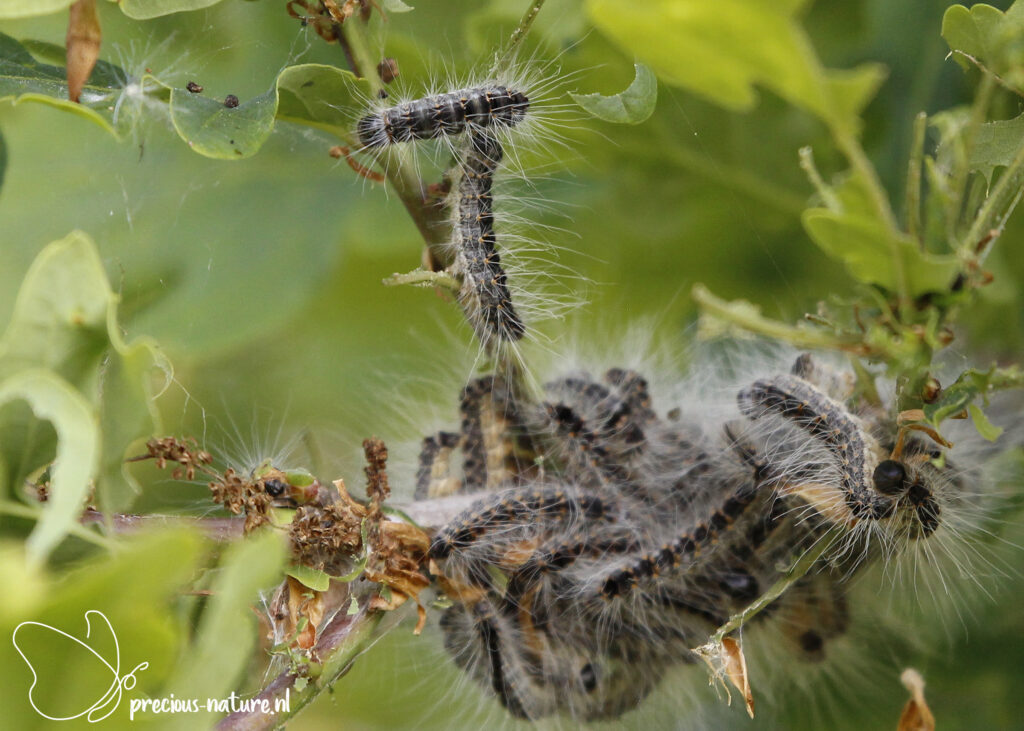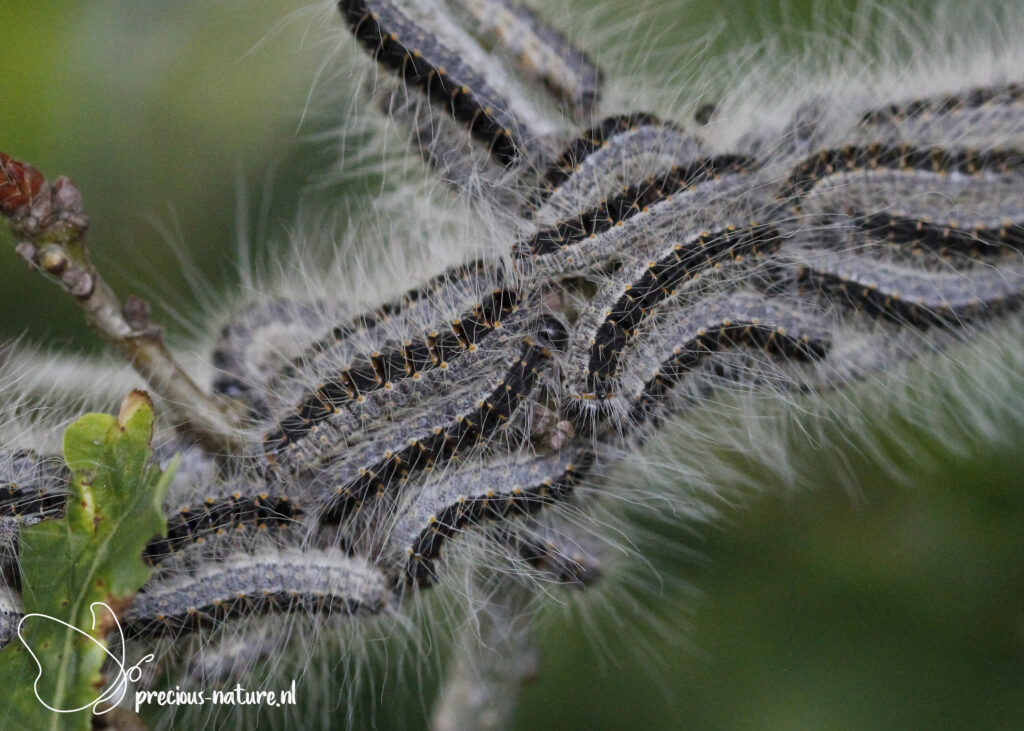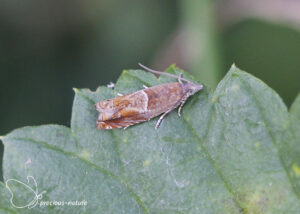Prominent Moths (Notodontidae) have a thick body and a hairy appearance. Most have long and tapered front wings that are held vertically against the body in the resting position. In some species, you can see a tooth-shaped protrusion on the inner edge of the front wing when in the resting position. During the day, you hardly encounter these moths. The species that I have spotted so far have been attracted to light with a special lamp.
Subfamily: Notodontinae
Genus: Drymonia
Indistinct Marbled Brown – 2023 (BE)
(NCBI-index: 988177)
The Indistinct Marbled Brown (Drymonia obliterata) is very rare in the Netherlands and the northern half of Belgium. This prominent moth is widespread in southern Belgium. So, a nice observation for me when I checked the moth trap during a visit to the Ardennes. The ground colour of the forewing is greyish brown. The central transverse lines are mainly notable for their double or single black deposits. The inner transverse line, especially at the inner edge, has a striking zigzag course. Characteristic is the dark triangular spot on the outside of the outer transverse line, extending towards the wing tip. The tooth characteristic of this family on the inside of the forewing is small and barely noticeable. The thorax is dark, and the antennae of the male are more strongly combed than those of the female. The flight period is in one or two generations from May to early September, and the wingspan is 30-40 mm. Host plant: Beech, Oak, Birch. Dutch name: Beukentandvlinder. Frisian name: –
Flying period:

Subfamily: Notodontinae
Genus: Notodonta
Pebble Prominent – 2017 (NL)
(NCBI-index: 988002)
The Pebble Prominent (Notodonta ziczac) was a striking appearance for me due to the wood texture of this moth. The forewing is brownish-yellow with a white spot in the middle plane along the costa, with a black-brown spot on the outside consisting of all elongated surfaces. The legs are heavily hairy. It flies in two generations from April to September, and its wingspan is 40-45 mm. Host plant: Willow, Poplar. Dutch name: Kameeltje. Frisian name: Kamielflinter.
Flying period:

Subfamily: Notodontinae
Genus: Notodonta
Iron Prominent – 2017 (NL)
(NCBI-index: 753204)
The Iron Prominent (Notodonta dromedarius) has characteristic reddish-brown or rusty-brown streaks at the wing base and the dorsum. Near the termen is a red-brown cross band, which sometimes shows some yellow. This prominent moth is also dark grey. The colours and drawings may vary. Dark specimens occur regularly, with little to no red-brown. The top of the hindwing is light grey. The flight period spans two generations, from mid-April to late August, and its wingspan measures 35-40 mm. Host plant: Birch, Alder, Hazel, Oak. Dutch name: Dromedaris. Frisian name: Drommedaris.
Flying period:

Subfamily: Notodontinae
Genus: Pheosia
Swallow Prominent – 2019 (NL)
(NCBI-index: 988019)
They remain beautiful moths, the species of the Prominent Moths. The Swallow Prominent (Pheosia tremula) is certainly one of them. A beautiful specimen was attracted to the light and landed on my white sheet. It resembles the Lesser Swallow Prominent (Pheosia gnoma) but is distinguished by the inconspicuous white wedge-shaped spots along the dorsum. With the Swallow Prominent, a very clear wedge-shaped white spot can be seen. Furthermore, a black and brown trimmed band runs along the termen. There are white lines in this band. A longitudinal white band runs along the centre of the wing, with a black-brown oblique spot, which runs away from the apex. The wings are held close to the body at rest, steeply angled. The flight period is from mid-April to September in two generations, and its wingspan is 44-56 mm. Host plant: Poplar, Willow, Birch. Dutch name: Brandvlerkvlinder. Frisian name: Brânflerkflinter.
Flying period:

Subfamily: Notodontinae
Genus: Pheosia
Lesser Swallow Prominent – 2020 (NL)
(NCBI-index: 988018)
The Lesser Swallow Prominent (Pheosia gnoma) is very similar to the Swallow Prominent (Pheosia tremula), but has a bright white wedge in the inner edge corner of the forewing that contrasts clearly with the black colour. This white wedge has a wide base and always ends in front of the centre of the forewing. In the Swallow Prominent, this less conspicuous wedge extends beyond the centre of the forewing. The silvery-white forewing is narrow and tapered. There are dark brown or black spots along the edges. The flying period spans from mid-April to the end of September, occurring in two generations. The wingspan is 45-50 mm. Host plant: Birch. Dutch name: Berkenbrandvlerkvlinder. Frisian name: Bjirkebrânflerkflinter.
Flying period:

Subfamily: Phalerinae
Genus: Phalera
Buff-tip – 2019 (NL)
(NCBI-index: 753216)
The year 2019 was the year of the beautiful spots. This included a beautiful Prominent Moth, the Buff-tip (Phalera bucephala). This moth has grey-white colored wings with a striking large yellow spot near the apex and a flattened yellow, brown-rimmed head. In the resting position, the wings are folded around the body, making the moth look like a broken birch twig. Halfway through the wings, there is a double transverse line of which the inner is light brown and the outer dark brown to black. This combination also stands as a partition for the large yellow spot. I also spotted the caterpillar, which is a striking yellow-orange with a distinctive black spot pattern. The head is black with an inverted yellow ‘Y’ on it. The eggs, white spheres with a black dot, can be found at the bottom of the leaves of deciduous trees. The flight period spans one generation, from April to August, and its wingspan ranges from 44 to 68 mm. Host plant: Willow, Birch, Oak, Linden, Hazel. Dutch name: Wapendrager. Frisian name: Wapendrager.
Flying period:

Subfamily: Ptilodontinae
Genus: Pterostoma
Pale Prominent – 2018 (NL)
(NCBI-index: 987447)
An interesting species is the Pale Prominent (Pterostoma palpina). It has a characteristic appearance when resting, resembling a piece of wood. Most notable are the long, protruding, slightly upwardly pointing labial palps. The males also have two hair tufts at the end of the abdomen. The narrow forewing is greyish-yellow with dark veins and dots. In a resting position, a striking rectangular, dark-edged comb is visible on the back. The fringes of the wings are sometimes scalloped, and the antennae are very strongly feathered in the male and only slightly feathered in the female. The flight period spans two generations, from April to September, and its wingspan ranges from 35 to 55 mm. Host plant: Willow, Poplar. Dutch name: Snuitvlinder. Frisian name: Snúttoskflinter.
Flying period:

Subfamily: Ptilodontinae
Genus: Ptilodon
Coxcomb Prominent – 2020 (NL)
(NCBI-index: 987449)
The advantage of not attracting moths in your backyard at home, but in a tree-rich environment, is that you can spot other species. The Coxcomb Prominent (Ptilodon capucina) is an example of this. The forewing of this moth has an even light or dark warm brown ground colour. The teeth on the inner edge of the forewing form a striking dark brown bulge on the dorsal side when resting. A characteristic large hairbrush is visible on the breast piece, which is colored light yellow at the top and points forward like a kind of crown. The flying period spans from mid-April to early September, occurring in two generations. The wingspan is 35-40 mm. Host plant: Birch, Oak. Dutch name: Kroonvogeltje. Frisian name: Kroanfûgeltsje.
Flying period:

Subfamily: Pygaerinae
Genus: Clostera
Chocolate-tip – 2021 (NL)
(NCBI-index: 987902)
In the resting position, the Chocolate-tip (Clostera curtula) keeps the wings folded around the body. The abdomen protrudes slightly, and the head appears conspicuously flattened at the front. This is enhanced by dark brown hair. The forewing is speckled grey-brown, over which three white transverse lines run. Characteristic is the broad, sharply defined dark brown with a reddish-brown spot that can be seen on the outside of the outer white transverse line. The Chocolate-tip is distinguished from the Small Chocolate-tip (Clostera pigra) by the much larger and much darker spot. In the Small Chocolate-tip, that spot is lighter in colour and less sharply defined. The wingspan is 27-35 mm, and the flight period is in two generations from mid-April to mid-September. Host plant: Poplar, Willow. Dutch name: Bruine wapendrager. Frisian name: Brúne wapendrager
Flying period:

Subfamily: Pygaerinae
Genus: Gluphisia
Dusky Marbled Brown – 2021 (NL)
(NCBI-index: 987944)
The forewing of the Dusky Marbled Brown (Gluphisia crenata) is grey with reddish-brown. The characteristic of this moth is the faint light comma spot in the greyish-brown median band. The colour and markings are variable; there are light species, but also dark specimens with a barely recognisable median band, which is further delimited by dark, slightly offset transverse lines. The flight period is from May to August in one generation, and the wingspan is 28-34 mm. Host plant: Poplar. Dutch name: Populierentandvlinder. Frisian name: –
Flying period:

Subfamily: Stauropinae
Genus: Furcula
Sallow Kitten – 2017 (NL)
(NCBI-index: 987943)
The Sallow Kitten (Furcula furcula) is very similar to the Alder Kitten (Furcula bicuspis) and the Poplar Kitten (Furcula bifida). The Sallow Kitten is grey-white with fine black pollination on the forewing (not for the Alder Kitten) and a broad grey, sometimes yellowish median band. This median band is bordered on the inside with a straight dark edge and on the outside with an irregular black edge. With the Alder Kitten, this band is much darker, and closer to the costa it becomes narrower. The difference with the Poplar Kitten is, besides this moth being larger, that the median band is bordered with much darker lines. The top of the thorax of the Sallow Kitten has the same colour shade as the middle band. The flight time is from April to September in two generations, and the wingspan is 27-35 mm. Host plant: Sallow, Aspen, Poplar. Dutch name: Kleine hermelijnvlinder. Frisian name: Lytse Harmelingflinter.
Flying period:

Subfamily: Stauropinae
Genus: Furcula
Poplar Kitten – 2024 (NL)
(NCBI-index: 987942)
You have to pay close attention to the markings of the Poplar Kitten (Furcula bifida) to distinguish it from the Sallow Kitten (Furcula furcula). Of course, it is larger than the Sallow Kitten, but if you don’t have them next to each other for comparison, it becomes more difficult. Another distinguishing feature is the thick black edges along the wide grey central band. The outer edge of the central band is usually flowing, slightly curved and extra thick at the leading edge. In the Sallow Kitten, the edges are less conspicuous, and the outer edge of the central band is somewhat serrated. The flight period is from mid-April to the end of August in two generations, and the wingspan is 35-45 mm. Host plant: Aspen, Willow. Dutch name: Wilgenhermelijnvlinder. Frisian name: –
Flying period:

Subfamily: Stauropinae
Genus: Harpyia
Tawny Prominent – 2018 (NL)
(NCBI-index: 988122)
The Tawny Prominent (Harpyia milhauseri) is easily recognisable with dark grey to black veins on the light grey forewing. Two black parallel wide lines run along the inner edge of the forewing. Just before the apex is a wide yellow-brown band. On the white hindwing, there is a striking black spot in the inner edge corner. The antennas are three-quarters sprung. The flying period spans one generation, from April to July, and the wingspan measures 50-60 mm. Host plant: Oak, sometimes Beech and Birch. Dutch name: Draak. Frisian name: Draakflinter.
Flying period:

Subfamily: Stauropinae
Genus: Stauropus
Lobster Moth – 2020 (NL)
(NCBI-index: 753423)
A well-recognisable species, which gets its name from the special look of the caterpillar, is the Lobster Moth (Stauropus fagi). Both wings have a grey-brown ground colour, with, especially at the base, a grey-yellowish pollination. A reddish-brown zone can be seen along the dorsum of the forewing. The serrated outer transverse line is white-yellow, and the broad line along the marginal area consists of a row of black dots. In the resting position, the hindwing extends below the costa of the forewing. The wingspan is 45-60 mm, and the flying period is from May to mid-August in one generation. Host plant: Beech, Hazel, Oak, Birch. Dutch name: Eekhoorn. Frisian name: Iikhoarnflinter.
Flying period:

Subfamily: Thaumetopoeinae
Genus: Thaumetopoea
Oak Procession Moth – 2018 (NL)
(NCBI-index: 499230)
An unexpected guest in the North is the Oak Procession Moth (Thaumetopoea processionea). It is often negative in the news when there is a lot of nuisance from the caterpillar of this Prominent Moth in the middle and south of the country. The forewing shows some black, inwardly tapering transverse lines and an indistinct comma-shaped central dot. The forewing is brownish to yellow-grey, and the wing root is always strikingly lighter colored. The flight period is one generation from July to September, and the wingspan is 25-35 mm. Host plant: Oak. Dutch name: Eikenprocessierups. Frisian name: Ikeprosesjerûp.
Flying period:


